#but this is why I recommend going as close to the original sources as possible
Text
A clarification on Athenian Laws concerning male homosexuality.
(because this particular small thing is often misunderstood, due to inability to accurately translate specific ancient greek terms into english, or lack of comprehension of context.)
In classical athens, there was a very specific set of laws, concerning ONLY male athenian citizens (so slaves, women and metics were not subject to it). These laws said that a male athenian citizen who engages in intercourse with another man IN EXCHANGE FOR PAYMENT, was not allowed to do certain things, such as hold positions of power or speak in the assembly. There were also potential penalties (not described in detail) for the person hiring an athenian citizen for this purpose. Again, this is often misunderstood, so I have to repeat, this was only when it was done in exchange for some sort of payment/recompense. The word used for these men is of the same root as εταιρα, which was the female counterpart. It is often mistranslated, there's a whole thing I could go on explaining about the different types of prostitution terms, but basically there was a distinction between prostitute and courtesan/escort/whatever you'd call them in english.
Also, this law did not forbid this, and it was not a prosecutable offense by itself. The offense was if one such man disobeyed the limitations set by the law, and it's unclear to me what the deal was with the person who paid.
SO yeh. Next time someone says there were laws against homosexuality in classical athens, here's a helpful article of a guy explaining this much better than me, and goes into more detail about all the weird intricacies of the legal system, as well as the laws set in place to protect boys from grown men:
and here's our original source about these laws:
#tagamemnon#ancient greece#this isn't my field of expertise so if i've misunderstood anything let me know#but this is why I recommend going as close to the original sources as possible#always#because it would've been easy for someone to mistranslate this one term#and someone who doesn't know the context of the entire text#might read that and think all bottoms lost their rights in classical athens or something#which would make no sense because alcibiades was publicly called a bottom in plays which would mean that ppl knew it#(or the joke wouldn't work i think)#but he held the highest possible position for a short while after his recall to athens#also to anyone who says these relationships were only for adult men and teen boys#pausanias and agathon were lover-beloved when they were both grown adults#agathon is around thirty in the symposium#and they even left athens together at the end of their lives#ANYWAYS UR WELCOME HAVE A NICE DAY
87 notes
·
View notes
Text
List of original research topics for nordic reconstructionism
I’m going to write down a few ideas at the top of my head, so I’m sure I’ll be leaving some stuff out. Please don’t assume that researching every one of these is mandatory, they are all personal recommendations. I’ve been identifying as norse pagan for a decent eight years now, and I find that there really is no limit to how much you can learn about nordic history and religions, which is why I’ve compiled a handful of topics I found interesting to learn about!
Now, I hope these can help people who already know a bit about heathenry, but also pagans of all paths who are interested in getting started with nordic history, norse pagan belief, practice or else, and who don’t really know how to get started!
(For those interested in getting started right away, I've directly compiled a few of my favorite sources in this previous post.)
Divination and magical work methods in ancient Scandinavia: seiðr, galdr, rune carving, taufr… The possibilities are endless.
Funeral rites
Non-religious oral tradition
Skaldic poems and skaldic poetry as an art form
Folk belief
Practices surrounding seafaring, and relationship with the land in general
Seasonal celebrations and traditions
Culinary and harvest practices
Visual arts such as carving, metalwork and the like
Folkloric and historical figures
Symbolism and kenning meanings
Theorized origins of certain traditions
Music in ancient Scandinavia
Interaction with European and Mediterranean cultures
Ways in which rites and rituals were performed
Differences in religious practice according to region
Surviving religious and non-religious traditions (make sure not to appropriate any surviving practices, as they are most likely considered closed)
Languages spoken in ancient Scandinavia
Medicine and use of plants
Hoping this gave some of you a few ideas!
#quick post#spirituality#history#norse paganism#paganism#polytheism#deities#heathenry#deity work#pagan#norse gods
109 notes
·
View notes
Text
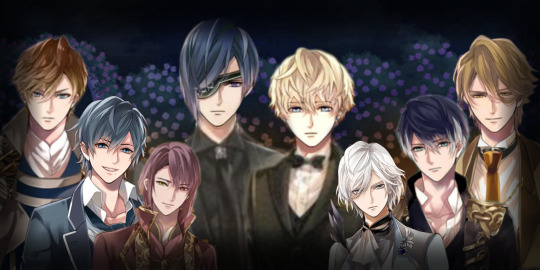
Mea Culpa - Vincent x Jean - Ikemen Vampire
-> The entire mansion was invited to a summer gala! Jean and Vincent sneak off for some alone time… Except- Oh no! They didn’t hear the footsteps behind them!!
Tags/Warnings <--> Slight crack, Humorous, Slightly fluffy, Supportive Family, Being Outed, Slight spice (is making out considered spice?), More kissing than I originally planned, Theo loses his mind, "Comte loves all his sons equally" (the mansion knows Jean the favorite- Jean does not), Arthur bullies indiscriminately
Word Count: 3203 (about 6 pages)
A/N <--> I had too much fun writing this. I genuinely don't know how I wrote this so fast. Also I recommend reading https://www.tumblr.com/koco-coko/737240114777948160/when-the-world-exploded-vincent-x-jean?source=share this if you want more context if not that'a fine
i think they might like this: @azulashengrottospiano @natimiles @weirdwriter69 (if anyone wants to be removed or added lemme know)

A summer night’s gala… What a romantic scene. The heat and humidity of evening air, the faint glow of candlelight, the soft melodies of a piano and violin…
It was a beautiful event, really. A friend of Le Comte’s invited him and the residents of his mansion to celebrate the summer solstice. It was the first summer after Jean and Vincent started their relationship. It wasn’t public, considering the era, but nobody in the mansion knew either. Maybe one day, but Jean was not ready for the amount of teasing comments he’d receive after this. Besides, only Sebastian and Mitsuki came from an ‘accepting’ era… How would the rest feel about something like this?
So, for the gala, Vincent and Jean stayed trapped in their own bubbles. Vincent hung around the food with his brother while Jean was a wallflower by Mozart’s piano. Jean would’ve approached Vincent by now, but unfortunately, the light of an angel attracted many people. Mostly women. All in their nice summer dresses with their fans, all swooning over the innocence and purity of the man before them. Theo seemed to fight them off fairly well by just… being Theo… but Jean felt something rising in him as he watched the crowd, tipsy and carefree, flirting with Vincent so openly. A green-eyed monster in Jean’s heart made his jaw tighten, only made worse by Vincent’s cluelessness and occasional discomfort when a lady in red mentioned the idea of courting him.
Jean tried to stay next to Mozart as long as possible. Except… the people really did love Wolfram, flocking around his piano to listen to his songs more intently. Jean’s discomfort then brought him to linger around Napoleon, but then Napoleon chatted with Isaac, who was being stalked by Dazai, and no way was he going anywhere close to Comte and that bundle of nerve and nobility…
Jean found himself at a loss in the corner. Why did he even agree to come to this place? He really wasn’t the type for fancy events. Even his suit felt stifling, though maybe that was the humidity getting to him. Jean pulled at his collar and wiped his forehead with his arm, scanning the area for any type of escape. The balcony already had lovers on it, enjoying the idyllic starry night. A single glimpse to the upper levels gave him the sight of an older man and woman clinking their glasses together. A young pair behind them was making their way to the balcony, whispering and blushing as they did.
His eyes traveled to a sandy-blonde without any command. The thought of passionate and amorous nights made his thoughts turn to Vincent in mere seconds.
Vincent was rubbing Theo’s shoulder while Arthur laughed about something, when suddenly he caught a glimpse of Jean staring at him. He waved, but his grin faded as he saw the anxious look on his partner’s face. Theodorus was starting to chide Arthur for something, not even realizing his older brother’s hand had left him. Vincent pointed to the open door, the only thing that caught the venue from being too stuffy to handle.
When Jean nodded shyly, Vincent made a beeline outside. Of course, the garden was filled with groups of people as well. The fairy lights and lanterns were just too nice to miss. Wine and lovey-dovey nobles littered the area. When Jean joined his side, that’s when he caught sight of a small place beyond the bushes. None of the fine ladies in their bouncy dresses would want to go through thorny bushes to somewhere so dark and secluded to flirt with their lovers (Well, there were a few unseemly sounds coming from behind the banquet hall… B-But they weren’t going in that direction! Vincent was actively trying to avoid places with sound, anyways…).
There weren’t many lights in the clearing beyond trimmed bushes, leaving Jean and Vincent alone in the dark. Still, by how close they were put together, there was no need for it. Jean grabbed Vincent’s hands and held them to his face, peppering both of his knuckles in kisses before he could even get a word in..
Vincent hadn’t even gotten a word in! He chuckled lightly. “What spurred this on?” Vincent asked, naive to the expression on Jean’s face. He looked desperate and helpless, as if being away from Vincent that long was torture for him.
Jean glanced to the side. “I do not know… I believe envy has claimed me tonight.” How embarrassing it was to admit such a deadly sin to his lover… He’d likely never live it down. “Seeing you with those women, I believe it has stirred something in me. Forgive me, monsieur.” Jean hid his pink face behind Vincent’s hand. They vaguely smelled of oil and lead. From here, Jean could even observe the dried paint behind his lover’s fingernails. It was cute, sort of.
When Jean looked back at Vincent, he had the most romantic expression, his smile almost reaching his ears. “Aw, Jeanie…” Vincent whispered. His hands moved from Jean’s grasp and onto his cheeks, causing the soldier to straighten himself into the proper standing position. “I’m sorry I didn’t realize they were trying to court me,” he said. Unconsciously, his finger rubbed Jean’s eyepatch as he spoke. It had become so natural at this point. “I’m not the best when it comes to that kind of stuff. But next time–”
“I will be there next time. To protect you,” Jean cut him off, although unintentionally. Neither had great social cues, it seemed.
The possessive tone in Jean’s voice made Vincent’s heart flutter quite a bit. He couldn’t tell if he was heated from the summer’s humidity or something else anymore. In all truth, Vincent had a possessive streak in him as well, but he had always pushed his jealous thoughts to the back of his mind. Despite everything, his habit of trying not to feel still had quite the hold on him.
Jean cleared his throat once he realized how long he’d been staring at Vincen’t face. “Apologies,” he mumbled, “That is only if you wish.”
A moment of silence dragged on between them, but the painter’s palms on Jean’s cheeks made him all too aware of the time that elapsed. Seconds felt like hours when he couldn’t hear his lover's sweet and soothing voice.
“I don’t mind,” he started softly, his hands slowly lowering. A distant sadness was behind his sky blue eyes, one Jean had come to learn all too well. His arms wrapped around his lover’s waist on instinct. “It’s just…” Vincent sighed and grimaced as the words struggled to leave his lips. “It’s times like these I wish they’d see us as real lovers.”
Jean’s heart had struck a chord. Vincent could tell from the tightening of his grip.
“It’s not that we aren’t,” Vincent explained, laying his head on Jean’s shoulder comfortably. “I know this–” he placed his hand on Jean’s heart and almost laughed when he felt it suddenly speed up, “–is real. But others are going to say it’s not, and I think that hurts a bit.”
Jean, despite a bit of stiffness, began to rub Vincent’s back as best he could. It wasn’t very soothing, but the gesture was appreciated. “I didn’t believe it either, at first,” Jean responded slowly, picking his words with care and precision, “But I do now. Maybe others just need time like I did.”
“And a lot of persistence,” Vincent teased. He couldn’t help it– not when Jean’s flustered pout was so cute!
Jean and Vincent always had a struggle with words and pinning down their true emotions into tangible sentences. It’s why Vincent had his art to escape to. Jean’s coping mechanisms were a little (a lot) less healthy (fencing his feelings out until he forgot about them), but both were actively trying to get better at this whole thing. A relationship meant communication and communication meant a lot of scary things.
Communication didn’t have to be just words, though. Vincent’s paintings revealed much broader ideas than even he realized, and Jean’s actions were much better at showing his true intent as well. So, with a short smile and one last scan for safety, Jean tightened his grip on Vincent and pushed their lips together.
Vincent loved kissing Jean, and vice-versa. It was much more personal and loving than they could ever voice. Jean, in all his shyness, was surprisingly passionate with every kiss and put his entire heart and soul into every minute of it. It was only exaggerated by his jealousy tonight. He pulled Vincent closer and closer, until their bodies were up against each other completely. He was also a die-hard fan of French kisses (I wonder why). Almost every session like this devolved into those. Not that Vincent was complaining.
Vincent smiled when their lips touched, nothing but accepting the moment. There were so few times they could display their love, and they both barely had any idea how to do that either. But here? For just a minute or so, they could pretend that they were your average, head-over-heels couple, unable to keep down their passions any longer. They could pretend that they didn’t have to hide and completely soak into the other with no pesky inhibitions to get in the way. Vincent wrapped his arms around Jean’s shoulders just as their tongues started to meet, his hand running up his neck and into the lower strands of his slate blue hair.
Oh, it was utter bliss. They could stay like this forever, if time let them.
“I KNEW IT!” A voice yelled beyond the bushes. They ignored it at first. Then, the stomping got closer–
“I TOLD YOU, I KNEW IT!!” Wait, was that Theo’s–!?
The bushes parted with a big swoosh just before the lovers could retreat their faces from the other, revealing Theodorus’s red face and gritted teeth. “YOU ARE STEALING MY BROTHER FROM–”
His eyes opened wide when he saw the scene before him. It was as if his whole world shattered right then and there. “... me.” Theo’s angry stance fell to one of complete disbelief.
Jean and Vincent… like two peas in a pod… Jean’s arms around his waist…. Vincent’s on his shoulders… their faces, red and flushed… inches apart…
“Um… Hallo, Broer!” Vincent laughed awkwardly, trying his best to put on a welcoming smile. No point in trying to move away from each other now. It was bound to happen eventually, right? Oh, why’d it have to be Theo? Even Arthur would’ve been better…
Jean, unlike his partner, was as still as stone, staring dumbstruck at Theo with wide eyes rivaling the little brother’s look of shock. He couldn’t even move. It was as if Jean had been completely frozen in time.
“Pal, what in the brother complex are you going on about?” Arthur was quick to join the scene. The partners in crime never seemed far apart, so it was only a natural development. He just had to glimpse at Jean’s tomato-red face once to burst out into laughter, holding onto Theodorus’s shoulder for support. Thankfully, Arthur was pointing at Theo and not the two currently in a tense embrace.
Suddenly, Jean shoved Vincent off of him. Vincent didn’t seem all too upset at that, quickly patting down his suit. Actually, he was thankful he did. With Arthur’s bellowing laughter, the real chaos soon began.
Mozart, then Sebastian, then Comte, then William, then Leonardo, then Napoleon– in that order. There were more, but the bushes were too dense for Vincent to see the others through.
“Is there something I should worry about happening here?” Comte asked gently, clearly confused by the combination of residents.
The playboy was doubled-over, clutching his stomach and wiping his face of tears. He could barely look at Theo’s traumatized face without wheezing. “Oh, nothing wrong, dear old dad! Just Theo walking in on his older brother’s love session!” Arthur barely had the breath to force those words out as he fell onto the grass. “Dear Gods, I’m about to piss myself!!” he snorted.
Mozart’s face was utterly disgusted as he tried to avoid the foliage, only to gaze at Jean and Vincent with mild disinterest. “That’s it? Here you had me thinking it was somewhat important. But…” Mozart’s expression softened when he saw Jean’s red face. The soldier still wasn’t completely in reality. Mozart snapped his fingers in front of his face, but it did nothing. “Vincent, huh?” he leaned over to observe the painter currently biting his lip and rubbing the back of his neck. “I did not expect blondes to be your type.”
“He’s not the worst choice in the mansion,” Napoleon added on, smirking broadly. This was currently… amusing. “Though, I thought Jean would be more into you, if anything.”
“I was going to tell you Theo– we were going to tell you all, really!” Vincent desperately tried to control the situation, stepping in front of the flustered Jean. “Just… Not now. But eventually! We didn’t know how everyone would react, and we’re just trying to take it slow and–”
William laughed heartily, approaching his friend with glee written all over him. “Th're is nothing to beest dainty about! i has't did kiss many a sir in mine own lifetimes!”
Vincent blinked and his expression dropped. “What?”
Shakespeare smiled lightly. “Actresses didst not exist in mine time. Juliet wast just a knave in a dress. Or I, if 't be true nobody else could fill in at rehearsals that day.”
“Oh… I see,” Vincent replied. Will pat his shoulder reassuringly, joined by a slap on the back from Leonardo. Jean and Vincent both recieved one as Leonardo came from behind them. Jean let out a soft ‘oof’ as he caught himself, finally waking from his humiliated trance.
“Welcome to the club, you two,” he said, grinning. “Man, I remember the day… I was almost arrested for something just like this when I was younger!” Leonardo gripped Jean’s shoulder and shook it. “Ah, memories.”
Jean glanced at Vincent, then at Will and Leonardo. “How many residents of the mansion are… like us?”
“More than you think!” Sebastian chimed in, grinning madly as his pen went all over the pages of his notebook. He slammed it closed quickly and hid it behind his back. “But that’s just a hunch. Take Napoleon, for example! He’s likely kissed almost every resident here!”
To that, Napoleon smirked and shrugged. He couldn’t really deny it…
“I can’t believe it,” Comte sighed, a hand over his chest as he gazed fondly at Jean. Jean’s face instantly scrunched up and he turned out. “I never thought I’d see the day Jean found happiness in another!” Comte’s face lit up as he made his way to Jean’s side and wrapped his arms around him for a quick, tight squeeze. “I’m incredibly proud. Maybe one day you’ll even open up to the rest of us.”
Jean looked as if he wanted to crawl out of his own skin. Mozart, Leonardo, and Napoleon all gave each other an exasperated, knowing glance. Comte wasn’t even trying to hide his favoritism anymore.
Vincent sighed, half-relieved and half-worried for the future ahead of them. He caught sight of Theo, still standing there with complete shock. At least, unlike Jean, he was blinking and looking around.
The brothers stared at each other for a bit. It was tense, at least on Vincent’s end. “Broer, I’m sorry–” Before Vincent could finish, Theo had closed the gap between them and embraced his older brother tightly.
“Why didn’t you tell me?” he whispered shyly, just as Vincent’s arms made their way around his younger brother. “I wouldn’t judge you for something as simple as this! I could’ve helped you! You didn’t have to hide all by yourself. How long have you had to bear this alone!? A month? A year??”
“Oh, Broer…” Vincent held his brother just as tightly, only moving back so he could pinch his cheek. Theo, although embarrassed, let it happen. “You really are a sweetheart sometimes. And I wasn’t alone, Theo. Jean was there with me!” Vincent looked over at Jean, only recently free from Comte’s smothering. By the look on his face, he was going to wash himself the moment they got home. Theo squinted at Jean. “He’s good to me, Broer. With Jean… I’m really happy with him. I promise.”
Theo’s glare didn’t stop just because of that. Jean met eyes with the little brother. It only added to the soldier’s nerves about such a sudden outing. If looks could kill, Jean was already a goner. Stabbed 29 times, shot 46, and probably a few broken bones.
Theo left Vincent’s arms and examined Jean in excruciating detail, head-to-toe. Once he had been thoroughly checked at all angles, despite Jean’s squirming, Theo leaned in close. Too close for comfort. Jean tried to lean back, only for Theo’s deadly glare and infuriated expression to come closer.
Theo pointed at Vincent. “You even think about breaking his heart, and I will hunt you down until the end of time and cut your dick off. You got that?”
“Broer!” Vincent exclaimed, “Language!”
Jean heeded Theo's warning, nodding his head quickly.
“Oh, old pal,” Arthur said, finally able to stand and dust himself off. He quickly went to his long-time friend and leaned on him. “That look on your face… Whoo, I’m never letting you live that down!”
The night continued on fairly normally, with only a few residents who weren’t present at the scene asking for clarification (Mostly Isaac, considering his era). The residents were surprisingly welcome to the idea, though maybe the whole vampire thing put the small stuff like this into perspective.
Things were a lot different back home, though.
For one, Theo was always giving the death-glare to Jean when he was around. He was checking in on Vincent a lot more often, always making sure his Broer was always happy and satisfied. It was only after a few talks with Arthur and Comte that he started to lay off (Comte and Arthur? Teamed up? It had to be serious).
Arthur and Dazai would often have teasing remarks, to Jean’s displeasure, but it was really only in the first few weeks that they were bad. Isaac nodded to them anytime they said a word, considering they were now fodder for jokes.
Comte was… more than proud, to say the least. If Jean ever mentioned that he wanted to take Vincent to a show, tickets would magically appear on his bedside the next day. Sebastian joined Comte, hiding around the corners near them a lot more often to take notes. This need for information (Comte was more on the: making sure his sons’ were always content side of things) led to a truce about the notebooks between the master and butler.
Despite all the changes, or lack thereof, there was one change that the lovers were the most fond of.
Finally, finally… Vincent could leave a peck on Jean’s cheek anywhere he’d like. Right in front of the dining table, after a sparring match with Napoleon… and nobody would bat an eye.
It was the simple things that meant the world to those two.

#ikevamp#ikemen vampire#ikevamp jean#ikevamp jeanne#ikevamp vincent#koco talks ikevamp#ikevamp fanfic#I wrote this in the span of 5 hours#6 pages....#vincent x jean#vincent x jean ikevamp#jean x vincent ikevamp#jean x vincent
22 notes
·
View notes
Note
Hii! First of all, I'm an old follower of yours and I always loved your gifs. Recently I started watching Shōgun thanks to you. I didn't read the books (are they good?), but I'm really enjoying it. The only thing that bothers me is that they keep bringing up how John and Mariko are close to each other, while it's been a few episodes now since we saw them being intimate (I don't mean the sex scene in particular, but them being alone, deep conversations or little things, anything). It's like everybody understood the thing between them, but they're not doing much. If they wanted to keep the focus on their relationship, why didn't they show us more of them? I'm all in for the yearning, it's not like I want them as a couple right from the start, but this all talking about them but at the same time leaving them to the sides feels weird. What do you think about it? Sorry, this ask is too long (:
First of all, thanks for being a long-time follower! And I'm glad you started watching Shogun. I did read the book late last year after I found out about the new FX adaptation and it was amazing. I really recommend it. It's only one book but it's very long. 1,300 pages approximately.
As far as what's going on with John and Mariko. You're not the first person to notice this and I guess I should've seen this coming after going back recently and reading some of the earlier reviews of the show. Some journalist made a point to say that the core romance between them "fails to ignite" in a Hollywood Reporter article and in others that the romance from the book/original miniseries had been purposefully minimized. I don't necessarily think it's failed. It's igniting alright, it's just not living up to its full potential and is leaving us all a bit confused and frustrated after getting invested, especially those of us that have read the book.
(IN MY OPINION) I think this was a creative decision by the showrunners to make a more culturally sensitive and historically accurate show set in feudal Japan. This also explains why they haven't missed a beat on Buntaro's jealousy subplot while they've left out a lot of what Mariko and John go through together. I may not like it because I believe it really hamstrings John and Mariko's personalities and alters their motivations moving forward and even possibly the ending, but I really think that's why we haven't seen them interact after episode four other than some yearning glances and frosty conversations.
Never fear though, I still think we'll get some great moments between them coming up soon and probably in this next episode as Shinnosuke Abe's (who plays Buntaro) latest Instagram post hints "As Buntaro, I don't wanna watch this episode" coupled with the trailer for episode eight. Sounds like Mariko may have had enough of his crap and gives in to her feelings for the Anjin? Finally? Please?! We shall see. I don't want to get anyone's hopes up, I'm just going by what I know to be true in the book but can't say for sure because adaptations have a way of telling a different story than their source material.
Anyway, this was long. Hope it helps though, lol.
12 notes
·
View notes
Note
hey, im really new to gellenic polytheism and im wondering where good places to research are because there is lots of misinformation and contradictions in lots of places thank you in advance if you respond 😊
This is gonna be a long ranty post with a brief summary at the very bottom, so you can skip to that if you’d like (but you would miss the reasons as to why I do research the way I do!)
First off, I’d like to mention that a lot of the time in my experience, people tend to be the best resource! Learning their beliefs, how their experiences are, help a lot. However, obviously this wouldn’t be enough on it’s own, especially since each person’s relationship with Hellenic polytheism is different and unique!
I’d also recommend checking out some myths, some books about it, etc. I personally have read the Iliad (and am about to start the Odyssey) and it gave me a greater understanding of how the deities existed in their original mythology and religion so I’d also say that while reading overviews of the myths are always nice and simple, I think you should at least try to read as close to the original as possible. Good places to get big books on the myths for free online are gutenberg.org and the Perseus Digital Library.
Then there’s the actual history of their worship. For this, I’d recommend just going on as big of a deep dive as possible on the internet anywhere you can. My personal rule is 3 websites have to agree and if they don’t then I cross that off the research as inaccurate. When I first started deep diving into this topic on Lady Aphrodite for example, I went to a YouTube channel called ‘OverlySarcasticProductions’ and watched any videos they have about Lady Aphrodite. Then I went and fact checked them with different websites and books I found on Lady Aphrodite and learnt even more that way.
There are obviously websites, and I think everyone knows a lot of them! theoi.com, worldhistory.org, greekmythology.com are some good first base ones, but when going deeper, I’d recommend reading things to do with the deity anywhere you can. For example, some of my research on Lady Aphrodite came from someone’s thesis which was posted online and then I went to check their bibliography and checked those sources as well. Never forget to check references because if there is an option to have references and citations and they don’t give them, I’d say not to trust them.
TLDR:
Listen to other people’s experiences in the community on social media (don’t base everything off what they say though)
Read the actual myths (in as close to the original format as possible if you want to go that extra deep step - check out the links in the section for resources on that)
YouTube can be your friend! Just make sure to triple check anything they’re saying (this goes for every piece of research you do!! Don’t just take things as facts)
Check out people’s theses on topics and check out their citations and bibliography
Remember to go back to the roots and check things like theoi.com, worldhistory.org, greekmythology.com, etc. Just because they might seem like ‘middle schoolers websites’ sometimes doesn’t mean that they’re not valuable
And just remember, your research is never over! This is such an ancient religion and we’re still finding out things about how it worked, and I doubt it’ll ever be fully learnt about. Always keep researching, because you’re never done learning.
5 notes
·
View notes
Text
Cafe Mambo – Paia, Maui, HI


Happy Hour at Cafe Mambo – Paia, Maui, HI
Updated 10/25/2022 by the Maui Happy Hours team
Happy Hour at Cafe Mambo Paia from 3pm-6pm Daily
Happy Hour Appetizers
- Chips and Salsa $6
- Onion Rings $8
- Fries $6
- Mambo Fries (Pork & Cheese) $10
- Cheese Quesadilla $8
Happy Hour Beers $4.50
- Corona
- Peroni
- Bikini Blonde
- Big Swell
- Seasonal
Happy Hour Cocktails $7.50
- Margarita
- Lilikoi Margarita
- Mango Margarita
- Bloody Mary
- Mimosa
- Maui Sunrise
- Mambo Gin
Happy Hour Wine $5.50
- Pinot Grigio
- Chardonnay
- Sauvignon Blanc
- Tempranillo
- Champagne
——————————
Address: 30 Baldwin Ave, Paia, HI 96779
Phone: (808) 579-8021
Website
About: Cafe Mambo Maui has been serving locals and tourists in the eclectic surfer town of Paia since 2003 and was once voted “Best Lunch” and “Best Burger” by readers of the Maui Times.
It’s a funky, vibrant restaurant serving a creative menu of locally sourced burgers, fajitas & salads.
Located in the seaside village of Paia, Maui, Cafe Mambo is the perfect stop when leaving for a day on the Road to Hana.
Popular items at Cafe Mambo include their Crispy Duck Burger, Loco Moco, Mambo Burger, Seared Ahi Burger, Fish Tacos, and more.
Cafe Mambo strives to use as many organic and local, Maui-grown ingredients as possible.
Happy hour at Cafe Mambo is from 3pm-6pm daily and features discounted appetizers, beer, wine, and tropical cocktails.
According to these Cafe Mambo patrons
“Great happy hour drinks and starters. Friendly quick service at Cafe Mambo.”Susan G., October 2022
“I’ve only visited the beautiful island of Maui twice. Once with my wife then again with her family joining. Both times we ate here. I love the fun laidback atmosphere, especially by the window seating. The crispy duck burger was one of the tastiest things I ate on the Island!”Justin G., September 2022
“First family vacation to Maui we had been on the road , just enjoying the beautiful sights on the road to Hana. We stopped in for a late dinner. The people were not only friendly , they also delivered a awesomely good meal. The seared AHI Burger exceeded my expectations, the Hawaiian burger was excellent as well. We’ll definitely be coming back to Cafe Mambo whenever we come back to Maui.”Cecy C., September 2022
“Cute little restaurant with a wide selection of options. The food was presented well and tasted great. The drink selection is very strong as well. I highly recommend this if you are looking for a great meal in a casual atmosphere. Also, please note that it’s easier to get in to Cafe Mambo than the restaurants down the hill. Well worth the short walk!”Kyle C., September 2022
“We went there mid September on a Friday night around 7pm. They closed at 8pm. The had their famed crispy duck fajita and the fresh fish fajita. Both came with an assortment of guacamole, sour cream, tomato sauce, salad etc served on a different plate, along with the fajitas and the duck and fish each on different plates. We loved both! The duck was juicy and crispy; but too oily. The fresh fish unfortunately overcooked. This is a nice , original place to hang. Easy going, great after surfing when hanging out with yiur friend. The staff was super friendly even we were the last guests before closing.Chris I., September 2022
“This restaurant is such a cute little spot to get a casual bite to eat, whether it’s breakfast, lunch, or dinner. We chose Cafe Mambo for an early dinner after doing the Road to Hana and were not disappointed.We ordered Onion Rings (with the Curry Sauce), Tofu Nachos, Roast Duck Fajitas. My favorite dish was the Roast Duck Fajitas. Our server mentioned this is what they are known for and I can see why. I loved how they served the fajitas in the unique metal dish for all the ingredients. The Roast Duck had a very nice sweetness to it.Also, take advantage of Happy Hour. We will definitely be visiting this restaurant again (maybe even for breakfast or brunch).”Keith K., February 2021
Want to make a comment or ask a question? Are you a fan of Cafe Mambo? Tell us in the comments below.








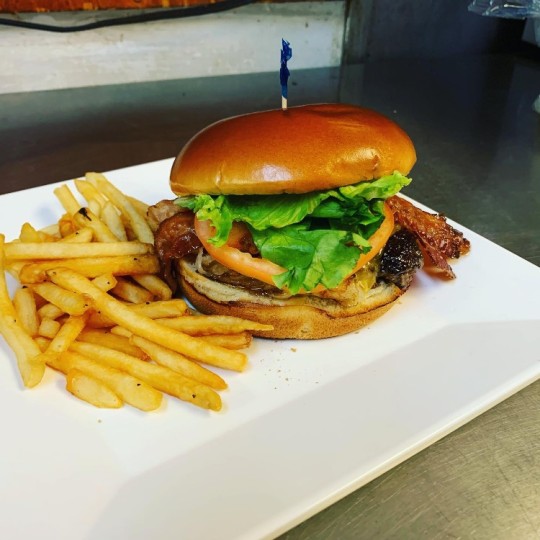







Download the Maui Happy Hours App (Free)
Advertise on Maui Happy Hours
The post Cafe Mambo – Paia, Maui, HI appeared first on Maui Happy Hours.
Read the full article
0 notes
Text
Dog trainer upset about losing space at Moncton community centre
A Moncton woman is frustrated and speaking out about losing space at a community centre that will become a temporary homeless shelter in the near future.
April Saulnier trains dogs two days per week at the Moncton Lions Community Centre.
Moncton city council announced last week the building will be a shelter for the city's rising homeless population, meaning all programming at the building will have to cease. The building is owned by the city.
Saulnier, who has 60 clients, says the dog training courses are her main source of income and she now needs to find a new workspace.
She's glad a shelter has been announced and is sympathetic to the plight of people experiencing homelessness, but the short notice to vacate the space has left her scrambling.
"Originally, we were told we could stay until the Christmas break. The centre closes for two weeks for Christmas, so that was already pre-planned,” Saulnier tells CTV Atlantic. “This week, they told us they were cutting that short, so we have to be out by Dec. 9, so that's a bit of a quick change.”
Saulnier said unfortunately with dogs, it's very difficult to find a place to go.
"Most people hesitate to allow dogs into buildings even if we're following all rules and recommendations,” she said. “It seems to be a challenge.”
Saulnier says since the building is a seniors centre, the focus is on trying to find new places for their programs to be held.
In a Facebook post, Saulnier said she's called 130 places in the Greater Moncton area and she's still waiting on some boards to approve her dog training courses.
"I’ve called every open space, every church, every place I could possibly think of. I’ve used every connection I’ve built," said Saulnier in Friday's post.
Saulnier went on to say she knows the shelter is much needed, but she's finding it hard to deal with the fact she's lost the venue where she earns a living.
"This is my job and how I support my children," she wrote on Facebook. "Why are we taking from one hand and giving to another without any additional thought to working small businesses?"
Moncton Deputy Mayor Bryan Butler told CTV News last week the shelter will have somewhere between 80 and 100 beds and will open on Jan. 1 at the latest.
from CTV News - Atlantic https://ift.tt/AnOTWvf
0 notes
Text
Abridged history of early 20th century Chinese womenswear (part 1: 1890s & 1900s) *improved version

Source here
*I’m fixing and reposting the first two posts of this series because back then I had no idea how Tumblr formatting functioned and they deserve better. I’m keeping the shoddy original versions for archival purposes.
*After some thought I think it makes more sense to group the 1890s and 1900s together.
Other posts in the series:
Part 1: 1890s (original)
Part 2: 1900s & 1910s (original)
Part 3.1: 1920s-silhouette
Part 3.2: 1920s-design details
Part 3.3: 1920s-accessories, hair & makeup
Part 4.1: 1930s-silhouette & design
Part 4.2: 1930s-hair, makeup & accessories
Part 5: 1940s
Part 6.1: 1950s-Hong Kong, Macau, Taiwan & friends
Part 6.2: 1950s-mainland China
Intro & context
In order to understand early 20th century Chinese fashion we have to go back a bit into the past to have some clue about the context. When the Manchus conquered China and established the Qing Dynasty in the mid 17th century, Han Chinese men adopted Manchu style clothing but Han Chinese womenswear remained independent and separate from Manchu womenswear. Han Chinese women retained the habit of wearing a two piece ensemble as the outermost layer, unlike Manchu women, who wore a single floor length robe. I will be only discussing Han Chinese women’s fashion in this series.
In the 19th century, Han Chinese women wore 袄裙 aoqun, a two piece ensemble consisting of a robe and a skirt. The robe had a very low 立领, standing collar. In the second half of the 19th century, the robe in aoqun had a very generous and roomy cut and huge sleeves, a look which reached its peak in the 1860s and 70s. The hem of the robe hit the knees, the length in vogue since the 1870s. The collar of the robe is very low, only providing enough space for one button, likewise in fashion since the 1870s. The robe is closed with 盘扣 pankou, which in this era were always plain with either a bead or fabric knot tip. The robe closes at the side, usually at the right side at the 大襟 dajin, the side closure, however examples of robes with closures on the left also existed. Robes with closures on both the right and left were also a thing, a style called 双襟 shuangjin, double closure. Shuangjin robes were derived from a men’s riding vest, the 巴图鲁坎肩 batulu vest (batulu is Manchu for “warrior”), that could be opened from both sides, and would experience a revival in the 1920s.
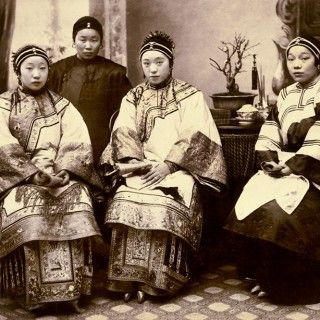
Source here
1870s/80s photograph of a group of women in aoqun, the two skirts on the left are the elaborate mamian style, the one on the right is plain.
In aoqun, the skirt was usually of a style called 马面 mamian, made of two long horizontal pieces of pleated fabric with two flat sections each sewn to a waistband with one flat section overlapping, creating a wrap skirt that once worn around the wearer’s waist, appears to have two unpleated sections, one at the front and one at the back. This skirt was very decorative in the 19th century, full of embroidery, tassels and elaborate trim, sometimes giving the illusion of a separate apron being attached (I’ve seen this weird stereotype that traditional Chinese womenswear has a separate apron at the front this is complete bogus). The robes were likewise heavily decorated around the seams, ceremonial outfits like wedding gowns could be so full of embroidery that the original fabric is hardly to be seen.
The combination of robe and pants, 袄裤 aoku, was also a common way of dressing since approximately the 1800s or 1810s. This combination would become the norm in the 1890s.

Source here
1870s/80s photograph of a woman in a ginormous ao, roomy pants and with bound feet.
Another noteworthy fad was bound feet. The middle of the 19th century was the pinnacle of foot binding and fashionable women had incredibly small feet, dubbed “lotus feet”. This was achieved by wrapping tight foot binding cloth around the feet since childhood and restricting the growth of the feet, I think also breaking a couple bones in the process. Women wore foot binding cloth and baggy stockings underneath their shoes, tied up with garters below the knees. Foot binding is said to severely restrict mobility and cause intense pain; I don’t doubt the pain part but I’m not sure about mobility since I’ve seen plenty of photographs of women with bound feet roaming about the streets.
Not every woman did foot binding though, it depended heavily on region, class and the individual family. For one, Manchu women all had natural feet. For Han women, an account from the 1850s said that in Beijing, every five or six out of ten women did not have bound feet, and that probability is three or four out of ten in the countryside. In the provinces along the southern coast, most women did not bind their feet (this probably has to do with the influence of indigenous cultures in the south, since foot binding was primarily a Han fashion), whereas in the northwest almost every woman had bound feet. By the way, I really don’t like how articles on foot binding describe it in the most sensational way possible, why is it so hard to approach history with peace of mind? And it pisses me off that all the articles containing 1890s photographs only talk about the foot binding as if there is nothing more of value in portraits of whole ass women.
Anyway, if you are interested in learning more about foot binding, check out Cinderella‘s Sisters: A Revisionist History of Footbinding by Dorothy Ko, recommended by @thefeastandthefast . Or just anything written by Dorothy Ko tbh.
Silhouette
In the 1890s, the cut of the aoqun began to become more slender and form fitting, commonly believed to be a result of westernization. But I think it’s also because the wide sleeve look has also been in fashion for quite a while now (some 80 years or so) and people were getting tired of it. The robe inherited the knee length hem from the 1880s but was less baggy and took on a more straight cut silhouette. The collar remained quite low until the end of the decade. Pants were overwhelmingly more popular than skirts in the 1890s, I speculate this may be due to a rising interest in feminism and women wanting more mobility, but aoku was also very popular in the 1870s and 80s in general so it may have also just carried over. The pants were still ankle length and straight cut but less roomy than earlier 19th century models. Overall the 1890s just looks like a shrunken and simplified version of the 1880s.

Source here
The aoku as of the 1890s.
By the second half of the 1900s, the collar began to rise, becoming medium height. This was kind of reminiscent of late 18th century Han women’s collars I mentioned in this post on Chinese standing collars. The robe and pants shrunk further, becoming quite tight fitting. The robe was still around knee length. The pants were especially tight and could be considered skinny. Foot binding became less common and many women had natural sized feet. However, since foot binding is something that begins in the childhood, the fact that many women without bound feet appeared in the 1900s meant that many parents started to reject food binding in the 1880s and 90s.

Source here
Ca. 1907 photograph of a group of women, possibly students, in tight fitting aoku.
Design details
The 1890s saw the mass disappearing of wide, embroidered trims around the seams, popular throughout the 19th century. The use of multiple rows of binding/trim from the 1870s and 80s was continued, albeit in a much more minimalistic and geometric way. I’ve seen a lot of plain white ao finished with multiple rows of black binding of different widths, it’s mighty avant-garde and elegant. Because clothes of the era were still constructed in the older Chinese method, they had a seam down the middle of the sleeves used to extend the length of the sleeves; this seam could be bound and decorated but it was not compulsory. Actual embroidery on the robe and skirt/pants was rare, if not non-existent; completely plain fabric was the norm. The ao of this era commonly had a 厂字襟 (厂 shaped closure), where the front placket is held up by one or two buttons and then closed by more buttons down the side seam. This style of closure was first popularized for Han women’s clothing in the 1800s and 1810s, before that Han women’s clothing closures were a straight line from the collar to the armpit. The pankou used to close the ao of this period became a lot more elaborate and the main source of decoration; I have a whole ass post on them here. A general air of simplicity, comfort and proportionality dominated the fashion of this era. In the mid 18th century, Han women’s robes started having folded cuffs (possibly borrowed from Manchu court dress), called 挽袖 wanxiu, and these became fake and represented by a piece of trimming in the 1850s. By the 1890s this design feature largely disappeared, leaving the sleeve edges either plain or simply bound.

Source here
Three women in aoku, late 1890s. I looooove the look on the far left, I will probably make it some day.
Going into the 1900s, the geometric trims became more simplified and austere, while the pankou became increasingly ornamental.
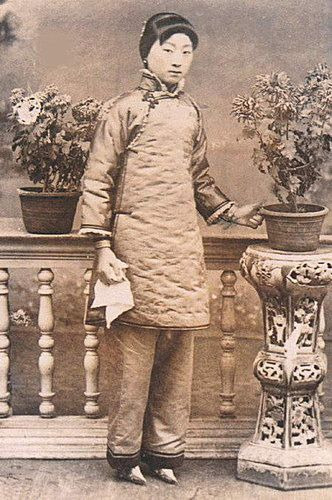
Source here
Late 1900s photograph. The robe is trimmed with fur and thin, geometric binding, and closed by very ornamental pankou.
Hair & Makeup
There were no significant changes in hairstyling in the 1890s, fashionable women would wear existing 1880s hairstyles but style them with bangs. A common style I’ve seen in photographs was long hair pulled back into either one big bun at the back or two smaller ones at the sides. The short bangs were usually very neat, precisely cut and sat closely to the forehead. Elastics did not exist, so Chinese women used strings and hairpins to tie their hair together. Hairpins of this era were usually very thick and sturdy, a single one was enough to hold all your hair into a bun. It was popular to use flowers and/or pearls to form a ring of decorations around a bun.
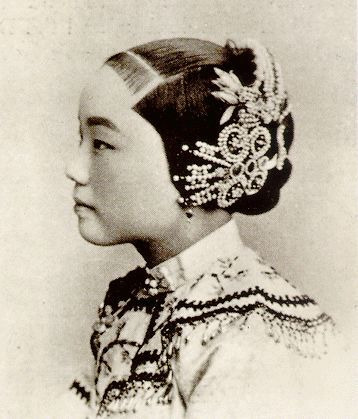
Source here
Common 1890s hairstyle, for most people the decorations weren’t so elaborate.
A popular headpiece was this thin headband adorned with pearls worn at the place where bangs should be, although that has been around since the 1870s as well.

Source here
Ca. late 1890s. Some women wearing the pearl headband.
Around 1905 the bangs began to grow in length but still weren’t long enough to cover the eyebrows. They were longer at the sides and shorter in the middle, creating this volume and curve at the forehead.
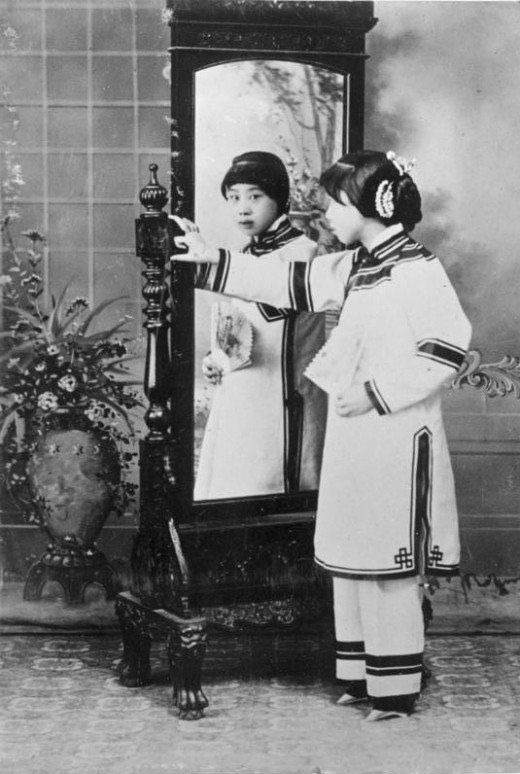
Source here
Photograph ca. 1905. Long bangs.
By the end of the decade these evolved into a being with a will of its own. Long hair tied into braids or low buns became fashionable instead of tight, high buns.

Source here
Calendar painting from 1911.
Fashionable women in the 1890s wore little to no makeup, because of the influence of female university students who were usually without makeup. In the 1870s and 80s, thick makeup was more common and was a trend popularized by sex workers in Shanghai, thus becoming increasingly considered indecent in the 1890s. I find this quite problematic cause respectability politics suck and there’s nothing wrong with wearing fashion trends invented by sex workers. All the straight male writers of the 1890s and 1900s praising female students for being “pure” and ”hygienic” in contrast to the supposedly nasty sex workers make me cringe to my core, it’s just pitting women against each other and setting us up for “I’m not like other girls” in my opinion.
The common makeup look includes white power, lipstick and blush. The lipstick shape was usually a tad smaller to the actual lips and blush was applied in large areas toward the outside of the face.
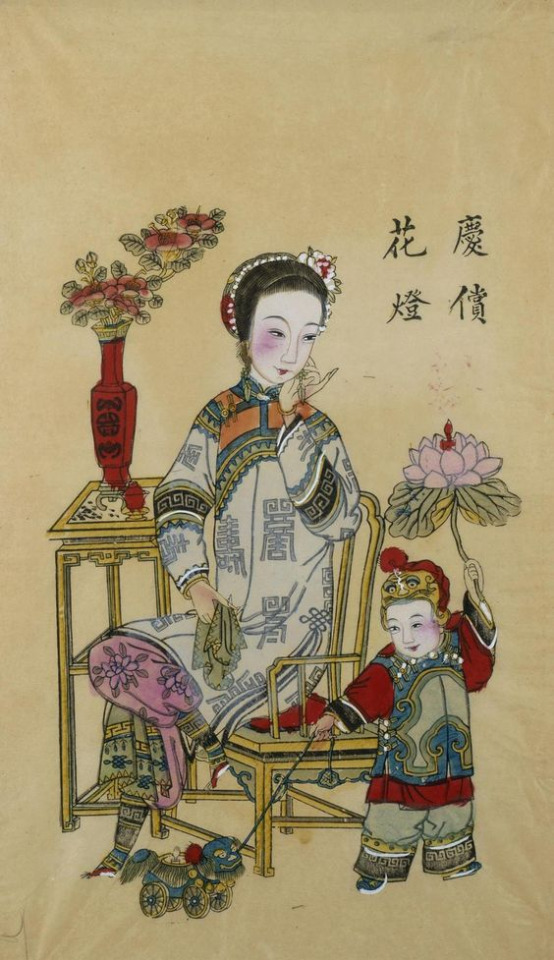
Source here
Standard 1890s and 1900s hair and makeup look. This drawing is probably from around 1902, it’s a bit more festive folk art than fashion plate so take the patterns with a dash of salt.
Undergarments
Unfortunately I don’t have many pictures for undergarments of the era but I can describe them to you. Since women commonly wore pants, they would usually wear another layer of pants (could be considered drawers) underneath that was of a similar construction but plain and easy to launder. Panties and such didn’t exist so drawers were the innermost layer, enough to protect women’s private parts. Likewise for the robe, another plainer, sturdier version would be worn underneath. In the mid 1900s, as the sleeves of the outer robe began to shorten, the undershirt became more form fitting at the wrists and could serve a decorative function.
Chinese women in the 19th century bound their breasts with long strips of fabric to achieve the flat look. I’m not exactly sure how this is done but basically you wrap fabric tightly around your chest until the boobies are concealed. A famous undergarment of the Qing Dynasty was the 肚兜 dudou, which was actually unisex. The female only version was called 抹胸 moxiong, 袜肚 wadu or 袜腹 wafu, the latter two are etymologically similar to earlier words for “corset” or “a pair of bodies”. However, unlike what many later 20th century artists would like you to believe, wearing only dudou on the upper body was not legit underwear for grown up women, as it was usually worn in conjunction with breast binders as an extra layer of warmth. It was also worn very tightly around the breasts and waist, not tied loosely like in paintings or period dramas nowadays.
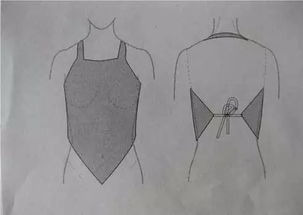
Source here
Dudou diagram.
Shoes
Women began campaigning against bound feet in this period and many drawings depicted women with natural feet. However, if a woman had her feet bound since childhood it’s difficult for them to return to their natural size, so some women who were born in previous decades would still have very small feet, even if they began to reject it at this time. Women’s shoes of Western construction weren’t yet so common so most women wore Chinese style shoes, which were commonly made of fabric and had a slightly upward pointing toe. Women with bound feet would use a long piece of ribbon/cloth to wrap their feet (to maintain the shape) and wear small fabric pumps with a white sole. These could be flat or have a teeny tiny bit of wedge heel, called 弓鞋 gong xie, bow shoes. Women without bound feet would wear normal sized pumps, likewise of fabric, with slightly upward pointing toes and a thick white sole. Embroidery on shoes was a huge thing in the 19th century and before but by the 1890s it started to disappear as well, and shoes in the 1890s were commonly plain. In the 1900s, Western leather shoes were increasingly popularized, but it wasn’t until the early 1910s that this popularity reached its height.
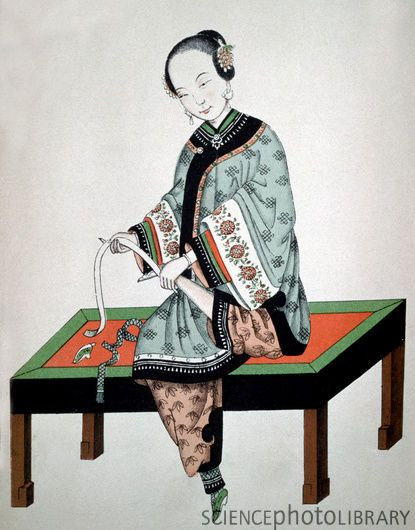
Source here
Foot binding cloth.

Source here
Shoes for bound feet.

Source here
Woman with natural feet wearing Chinese style pumps. Western style knit stockings were becoming popularized in the 1880s for women with natural feet as well.
Some editing afterthoughts
I’ve been looking more into 18th and 19th century Chinese fashion lately and I realized I held some deep rooted misconceptions about the Qing Dynasty. For some reason I always considered the 1870s and 80s look with the elaborate, big robes conservative or backwards, which is really not fair. Chinese women’s fashion was revolutionized in the beginning of the 19th century, going from the flowy, slender robes of the 18th century to stiffer, more structured robes with flared sleeves. Styles also differed dramatically from decade to decade, it’s just not very well studied and there’s a stigma around Qing Dynasty fashion so people don’t get into it as much. Because Han women were allowed to continue wearing Han style clothing into the Qing Dynasty, a lot of 18th century reproduction ensembles nowadays get mistakenly labelled as Ming style hanfu, which really isn’t helping... I was definitely not alone in this though, the perception of Qing Dynasty Han women’s fashion most people nowadays have is: in the first couple years Han women were allowed to wear Ming style hanfu, but then bam the late 19th century look was forced upon everyone. This view is super not nuanced and false on almost every level, but it is extremely widespread and I don’t blame you at all if you also think like this, this was me just two months ago too... A wise woman (I mean Karolina Zebrowska) once said that everything in fashion history happens gradually, which is also extremely true for Chinese fashion history.
I’ve really started to question what modernity in fashion means because the elaborate 19th century Chinese look that white people back then considered the epitome of conservative Chinese clothing was actually new and exciting in the beginning of the 19th century. I can’t help but wonder if this view that Chinese clothing as of the 1870s and 80s was symbolic of Chinese culture’s “backwardness” and “stagnation” was a product of colonization and white imperialists’ efforts to demonize Chinese society and take things out of context. I would prefer to say that Chinese fashion westernized a lot during the 1890s and 1900s but not necessarily modernized because what is modernity. Fashions change and that is the most normal thing on the planet.
If you read what white historians or politicians wrote in the late 19th/early 20th century about Chinese fashion or culture (which I highly recommend you don’t, that shit is detrimental to your mental health), it becomes obvious that the majority of them have no clue what Chinese fashion looked like before the 19th century and how we got to what we had in the 19th century in the first place, so they just assumed that Chinese fashion always looked like that and that we haven’t progressed as a culture in hundreds of years lmao. Bullshit pseudo-Darwinism at its finest. Oh or if you look up 18th century European Orientalist paintings depicting imaginary Chinese characters, the clothes they wore and the hairstyles they had were so far off from what actual 18th century Chinese fashion looked like to the point they felt racist and were uncomfortable to look at. I stumbled across so many of them when looking for 18th century Chinese painting and every time I see one it almost gives me a stroke. So I think it’s really important to acknowledge that Han Chinese fashion of the 18th century is a valid field of study.
In my original 1890s post I said that the elaborate embroidery and trimmings started to appear on Han women’s fashion around this time because of Manchu influence, I take that back because I’ve realized it’s a whack claim. I’ll explain it more when I make some posts on the 19th century later.
Reworked part 2 is coming soon as well :)))
#1890s#1900s#19th century#historic fashion#qing dynasty#vintage fashion#vintage hair#vintage shoes#chinese fashion#chinese history#abridged history of early 20th century chinese womenswear#清汉女装#edwardian fashion
407 notes
·
View notes
Text
Fontaine and its Archon (theory/speculation)
Notice: This article is about the upcoming region of Fontaine, my speculations are clearly seperated from canon proof. You are more then welcomed to add information on any of my posts via dms/comments/asks.
Keyword: Irony
Name meaning and real-life reference
Fontaine is the French word for fountain/water spring.
The city of Fontaine is a French city located south east of France. Château de Fontainebleau is the name of a French palace (A/N: I highly recommend checking out this stunning piece of architectural art).
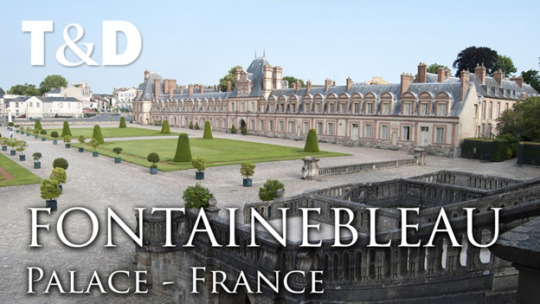
Therefore it is safe to assume this nation of Teyvat will be using France as its main real-life inspiration. Feudal France to be exact given Genshin's medieval like setting.
It is possible that Venice is a secondary reference.

“Venice has been known as the "La Dominante," "Serenissima," "Queen of the Adriatic," "City of Water," "City of Masks," "City of Bridges," "The Floating City," and "City of Canals."-Earth watching ESA
A city with many water canals sounds fitting for the hydro element, which Fontaine worships.
Water and masks(will be elaborated later) are the two most prominent concepts of Fontaine as of now.
The gadget “Kamera” originates from Fontaine in game. The inventors of cameras, the Lumiere brothers are French and early photography originated from France.
(A/N: If you know more parallels please let me know through an ask or a comment!)
The Hydro archon herself

Above is the gemstone required for hydro character ascentions. (Source: Honey Impact)
If you paid close attention to the wishful drop event(the quest that gives you Endora the mini-Oceanid), you can see that the Lochfolks like Rhodeia of Loch does not support the current hydro archon.
The Lochfolks are originally envoys, located in other six nations by the orders of the original hydro archon(one of the Original Seven). The original hydro archon wishes only to stay connected to the rest of the seven, therefore the Lochfolks mainly acted as messengers. But they do not seem to acknowledge the current hydro archon to be their boss.
The Lochfolk’s CN name is 纯水精灵, roughly translates to: “spirits/nymphs of pure water”.
“An assassin from our homeland? Or a fool who dares to tresspass the waters of Qingce?”
-Oceanid of Qingce, Rhodeia of Loch
The word "assassin". This implies that the current Hydro archon sees the Lochfolks as threats to her reign, and she had seeked/is seeking to eliminate them. Like Rhodeia, many of them have cut ties with Fontaine and is currently occupying bodies of water, waiting for their own demise. I suspect that politics and power struggle would be a heavy theme throughout Fontaine’s story quest. “Rhodeia of Loch” implies that there is/used to be a Loch clan in Fontaine. Albedo also said "we could bring in six Oceanids" during his experiment on the traveler.
There is also the title of the archon quest.
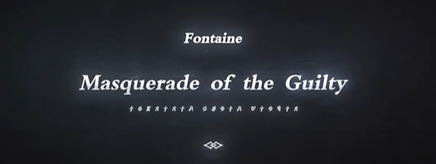
•The irony here being: Since the hydro archon’s title is the god of justice, then why is the archon quest of Fontaine called “Masquerade of the Guilty”? Maybe she obtained her position through unsavory means. (That is perhaps why the reason why the Oceanid refuses to recongize her as their god)
•Masquerade balls were quite popular in feudal Europe among the upper class. The attendees are obligatory to wear a mask, so their experssions and identity remains a secret.

•The CN title being “罪人舞步旋“, roughly translates to “The sinner’s whirling dance steps”
Both versions seem to imply this theme: someone had committed a crime, but said person did not recieved any punishment for it. Instead, they are enjoying a lavish, happy life. An outlaw who got away with their punishment.
The teyvat storyline preview lines about Fontaine:
“The god of justice lives for the spectacle of the court room, seeking to judge all other gods. But even she knows not to make an enemy of the divine.”
-Dainsleif the Bough Keeper
•It is a common tactic for someone guilty (of a crime) to accuse others to redirect attention. If the lochfolks are willing to answer to the Hydro archon, she would undoubtedly use them as eyes and ears to get dirt on the other archons. But she is not willing to go against the heavenly principles.
•My speculations on her true form: a mermaid/siren.
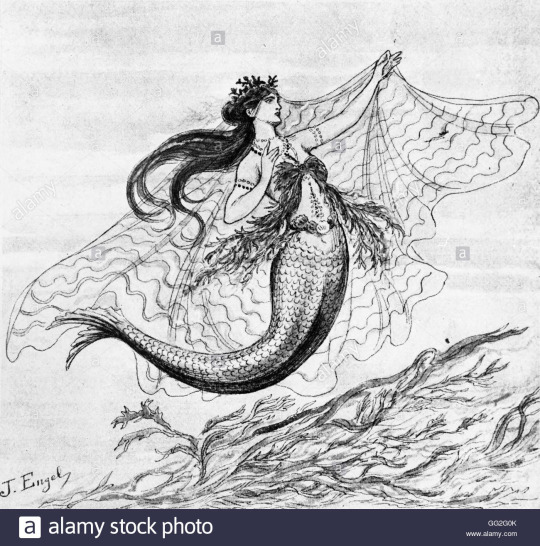
Sirens are mythical sea creatures, they appeared in several different cultures. They often have the appearance of breathtaking human women along with lovely singing voices. The word siren can be used in modern context if one wishes to describe "a woman who is very attractive but also dangerous"(Miriam Webster Dictionary).
Giving how frequent "guilty" and masks are mentioned, this divine lady of water seems to be a shady, trickster like character. And what's a water creature known for their deadly trickery? Sirens. Their singing attracted sailors and caused them to sail into dangerous water or toward rocks. Note that Sirens and Mermaids are not originally the same with seperate myths, see here. But popular depictions of them are often similar. In short, Sirens is commonly known to be a more sinister version of mermaids.
This could be symbolic to how Fontaine seems to be prosperous and peaceful on the surface level, but its fondation is nothing more then an enormous lie.
Fontaine storyline speculations
Some sort of revolution. Fontaine is based on Feudal France, so...
Rings a bell? Marie Antoinette, the Queen of France who is known for her ridiculous spending habits and "let them eat cake".
I do not think the hydro archon will get executed like the French Queen. Just stepping down from her divine position will be enough.
As formentioned, I believe politics and power struggles would play a big part in Fontaine's story arc. Agian, if you are familiar with the french revolutionary history, feel free to add to this!!
#genshin impact#genshin theory#genshin lore#genshin fontaine#fontaine genshin#oceanid#genshin impact theory
400 notes
·
View notes
Text
A Brief Revisit to My Volume 22 Analysis & New Theories
With this new chapter, and fresh knowledge that has come with the couple previous chapters, I wanted to revisit my initial analysis with some new theories!

As always, I recommend that you read my initial analysis to grow familiar with the theories I will be drawing on. You can read it here:
Volume 22 Cover Analysis
Now get ready to take this small abrupt journey with me! I will also be adding a trigger warning for blood, more specifically bloodstains, which are mentioned later in this analysis. This is also not proofread gkfkfjf
~~~
A Mini-Briefing:
"Biblically, however, it could also be related to something different.
"In the book of Job 26:9, the Bible reads:
“He covers the face of the moon, shrouding it with his clouds.”
One of the reasons why God would do so is to protect the moon. The covering was meant to hide the moon from view. In Joshua 10:12, we see God interrupting the normal course of the moon to ensure the battle that his servant Joshua was fighting comes to a successful end." - catholicsbible.com
I think in this context, Joshua would be Fyodor, mostly because Nikolai's coat is also covering him." - from my original analysis
To continue building onto this, we have not seen Nikolai appear yet. I have seen people bounce around the thought that Fyodor's ability might be revealed in the next chapter... but what if it wasn't? Nikolai's ability would allow him to transport Fyodor and Chuuya from the water-filled room to somewhere "safe" inside the prison. However, this is a game hosted by him, and it wouldn't be very fun if Fyodor had an "advantage"; to discredit my own theory further, Nikolai wants Fyodor dead just as much as Dazai. This leads me to my next theory.
What if Dazai is actually Joshua? What if Nikolai's coat is actually interrupting the normal course of the moon to ensure that Dazai's fighting comes to a successful end? Just a thought to continue bouncing around, as I wouldn't put it past Nikolai to have a narrative or plan of his own; after all, Nikolai is more than just an eccentric character and has a higher level of intelligence.
~~~

"It almost looks like the ocean. The ocean symbolizes power and strength, formlessness, the unfathomable, and chaos. I don't quite know where this would fit in yet, but I'd still like to take note." - from my original analysis
Well... this I should not have to explain too much. It could correspond with the debacle some favourites currently find themselves in!
In this circumstance however, I believe that the fact Fyodor is playing the card means that somehow this situation will cause the game to go into his favour. It is still possible that the card represents a mystery (i.e. something we don't know about yet), but creating theories is fun, so why not explore the possibilities!
It could also connect, once again, to tarot. The murky sky and choppy waters could connect to the Tower, while Dazai's card displaying Atsushi could connect to the Fool. I will review these cards promptly.
~~~
Chuuya... oh, Chuuya
~~~
Continuous Tarot Themes:
- The Tower

The Tower upright represents unexpected change, upheaval, chaos, revelation, and awakening.
- The Fool

The Fool upright represents beginnings, innocence, spontaneity, a leap of faith, and a free spirit.
It interests me that the corresponding themes continue to be depicted with both Fyodor and Atsushi. Once again, do not be afraid to share your thoughts!
~~~
Something I Haven't Noticed Before:
If you look closely at both Dazai and Fyodor's hair, you can see similar patterns to that of the Moon. The pattern also looks remarkably similar to that of blood spatter, which, knowing their characters, is probably what it is.
- Blood Spatter
There are seven different types of bloodstain patterns:
Passive bloodstain - drops, flows, and pools; these stains are typically from gravity acting upon an injured body.
Projected bloodstains - created when an exposed blood source is subjected to an action or force, greater than the force of gravity.
Impact spatter - a pattern caused by a high velocity impact or force to a blood source. They are typically produced by a gun or high speed machinery.
Cast-off bloodstains - a pattern created when blood is released or thrown from a blood-bearing object in motion.
Arterial gush or spurt bloodstains - a pattern resulting from blood exiting the body under pressure from a breached artery.
Wipe bloodstain patterns - a pattern created when an object moves through an existing stain, removing and/or altering its appearance.
Transfer/contact bloodstains - a pattern created when a wet, bloody surface comes in contact with a second surface.
Dazai - passive
Fyodor - passive as well
What this could mean - the patterns could be about the way/how they die, in Nikolai's game or outside of it. It could be droplets from their bodies reacting to the poison, or it could be from something else entirely. Either way, it is still something I would like to note.
~~~
Some Thoughts on "Her":
As I have been running on minimal brainpower today, I can't piece together much besides:
pretty and powerful criminal lady
maybe she's somehow related to the Order of the Clock Tower? A large stretch, but the clock drawn in the panel seems to look like the one of the Clock Tower...
~~~
Analysis Finale:
This analysis was a bit out of the blue, but my mind was wandering and I wanted to share those wanderings with you! I've said it several times and I'll say it again, please feel free to share your own thoughts and theories with me! I would love to read them!
#coff's analyses#bsd#bungou stray dogs#bsd analysis#bsd theories#bsd spoilers#bsd manga#bsd manga spoilers#bsd fyodor#bsd dostoevsky#bsd fyodor dostoevsky#bsd dazai#bsd dazai osamu#bsd osamu dazai#bsd chuuya#bsd chuuya nakahara#bsd nakahara chuuya#bsd sigma#bsd doa#bsd ada#bsd nikolai#bsd nikolai gogol#bsd gogol#bsd her
37 notes
·
View notes
Note
Hi! I am trying to become a japanese to English (& vice versa) translator. I can't find any sources to check the English to Japanese translation. It is difficult to get which grammar must be used since I am not a japanese native and don't know any natives to ask either. I have studied till N2 level but have no experience and must start freelancing to get experience so I need to figure out how to translate on my own. I can only use free translation software but I am not sure about it's reliability. I have seen questionable translations when it's for Japanese to English. Do think you can give any suggestions or anything that might be helpful?
Hi! I did put in a little time searching for the kind of tools you might have had in mind.
It seems that there are many that function in the exact same way but have different interfaces. Here are two of them. Many others can be found by searching "日本語文章校正ツール" or similar keywords.
https://dw230.jp/kousei/
https://so-zou.jp/web-app/text/proofreading/
While they can point out some things to look out for, from the testing I did with them, they overlooked some pretty obvious errors, while also catching some things that I couldn't figure out why it thought it was wrong/sounded bad, or how to fix it.
There was one more I found that I didn't try, because it involves downloading software. This page explains the software, and another page on the site offers the download. The webpage is sponsored by a university, so I think it's safe to assume its trustworthy, but it might be a hassle and I can't say for sure if it works.
https://www.pawel.jp/outline_of_tools/tomarigi/
--------------------
That said, it's most common for translators to work from one language INTO their native language. While interpreters often have to go both directions (J <--> E), translators typically work either (J -> E) [English native speakers] OR (E -> J) [Japanese native speakers]. If you grew up bilingual, maybe you can translate both ways. But if English is your native language and you learned Japanese as a second language (which is true of my situation), it's pretty much not going to be worth bothering to do E->J translation, unless there are extenuating circumstances. The reasons for this are 1) You can't be sure that the translation you produce reads smoothly or is error-free 2) While you might think, but yes, if I do a really thorough check and compare it against native Japanese examples, I can be pretty darn sure it's perfect, the amount of time it takes you to do that is not going to be cost-effective. Like anything else, people purchasing translation as a service usually want the end result to be done well, in a timely manner, and as cheaply as possible, so it doesn't make sense to hire you for E -> J when they could hire a native Japanese speaking translator, or send their work to an agency to find that translator for them.
If you ARE translating into Japanese and are not a native speaker of Japanese, it is a good idea to have a fellow translator who has the opposite native language you do (in this case Japanese & English), and ask them to check it over for you (which, considering that's part of their job, you'd probably pay a small fee for). They could do the same to have you proofread their translations into English. Some translators consult friends/spouses, etc., but I think this can get old for them sometimes, so it's advisable not to rely on them for your job. You mentioned not having any native speakers to ask right now, but this is still an idea you can file away for in the future when you meet more people and get to know other translators.
In short, if you're aiming to become a translator working with Japanese but are not a native Japanese speaker, don't worry about translating into Japanese. Just focus on translating from Japanese into your native language.
--------------------
Translation software: let me make a distinction here between "machine translation" and "CAT [computer aided translation] tools".
Machine translation is Google Translate, DeepL, anything like that. There are times when they work well, but particularly with a language like Japanese that likes to imply a lot of information instead of stating it directly (such as who is doing the action described in the sentence), they're pretty much always going to miss something. In any situation that someone is looking to pay a translator to do work, it's because they already know machine translation won't cut it. One thing that's becoming more common is MTPE (machine translation post editing), where a translator "fixes" what's wrong with a machine translation (or more often than not, just re-translates it from scratch because what the machine came up with is mostly useless).
CAT tools, on the other hand, are widely used by translators. Paid CAT tools such as Trados, MemoQ, Memsource, etc. can be very expensive, and are often provided by a translation agency to their translators. (Also, most of them require a PC operating system.) There's more I could say, but since I haven't been in any situations that require them, I don't have any personal experience. I do have experience using OmegaT (free, works on Mac) and Felix (free, I use it on Windows). They both take a little tinkering to figure out how to use effectively, but basically what they do is, once you've translated a segment of text, they store the original segment and the translated segment, and for each new segment you go to translate, the CAT tool compares it to segments that you've previously translated to see if you can re-use any of what you came up with before. They can also have a built-in dictionary function, but that's basically just having your typical web-based dictionary but more automatically and in a more convenient location.
--------------------
For going into freelancing, I have a few recommendations.
Apart from CAT tools, some resources that I refer to frequently are http://nihongo.monash.edu/cgi-bin/wwwjdic?9T (basically looks up all the words in a sentence at once), http://thejadednetwork.com/sfx/ (if you're doing anything with sound effects, like manga), https://tsukubawebcorpus.jp//search/ (this is a corpus, I have another post on how to use it -here-, it's probably going to be your best bet when it comes to checking grammar), https://books.google.com/ngrams (for when it comes to figuring out what turns of phrase are commonly used in English), and https://yomikatawa.com/ (for figuring out the readings of names in Japanese, though there are other sites that work similarly).
When it comes to practicing, contests are a good place to start. The two I know of now are run by JAT in October (https://jat.org/events/contests) and JLPP deadline of 7/31 (and they're long, so it's probably too late for this year unless you're free between now and then: https://www.jlpp.go.jp/en/competition6/competition6en.html )
You can also practicing doing translations for fun. Any kind of media you enjoy (manga, video games, variety shows, newspaper articles) is a good target for doing a practice translation. Just be wary that it's not a good idea to post your translation in a public location on the internet, because it could be infringing copyright/licensing agreements, etc.
Finally, there are websites like Gengo, Conyac, Fiverr and others where you can do gig translation work. They can be useful for practice, but also have the pitfall of paying, like, 5% of the rate you should be getting. This is an ongoing debate because on one hand, you can get practice while still getting a little money for it, but on the other hand, if customers can get people to do that work for 5% of a livable wage, that makes it harder for aspiring and working translators to find enough work that pays well enough to support themselves doing only translation for a living.
Entertainment (primarily manga) scanlation groups also a significant enough force to merit a mention here- many aspiring entertainment translators find themselves a part of such a group. Practice is practice and developing your skills is important, but they also have many many of the same problems associated with them as I mentioned above, namely infringing on copyright and contributing to the inability of anyone to turn entertainment translation into a livable full-time job.
Another recommendation I have is to join some J/E translation-focused groups. This page lists a number of them: https://shinpaideshou.com/translation/ I can personally vouch for JAT as I am a member and I got my current job by being part of their directory. They run an online training program (eJuku) once a year around April, and applications only stay open for a few days, so if you're interested make sure you keep your eye out. Another one not listed on that page is https://swet.jp/ which is not entirely about translation, but it is heavily related and they host some good events.
Twitter is also a very good place to be if you're getting into J/E translation. I prefer to keep my tumblr and twitter separate but if you DM me, I can give you my handle so you can see who I follow and who among that seems worth following to you.
--------------------
In closing, I see you say "I have studied till N2 level but have no experience and must start freelancing to get experience so I need to figure out how to translate on my own." I'd say, give yourself some time. Even at N1 there's still going to be a lot you don't understand (or at least there was for me, that's why I started this langblr). I'm sure there are differences in our situations, but it was about five years ago for me that I started diving into translation- I think I was between N2 and N1 then. I've done a lot of translating and gotten a lot of experience since then, but I also have and am experiencing a lot of burnout. (In fact, I'm procrastinating right now by answering this....) Many translators have a job and translate on the side, and it's also common to gain experience with a company or agency before diving into supporting yourself on freelance work. I'd encourage you to take a breath, get experience when and where you can, and remember that if you keep at it long enough, you're sure to get there- just don't wear yourself out or worry to death in the meantime!
OH and definitely keep track of what projects you do, how long they are, and how long it takes you to do them! Knowing your speed is important when it comes to setting your working rates. I am always doubting these, and they differ from person to person, but my current estimates are that I can do 600 moji (Japanese characters) per hour, ~10 min. of audio per hour, and I try to aim for $45~$60 per hour. Generally the lowest acceptable standard rates are $0.05-$0.06 per moji and ~$5 per page of manga. You'll definitely get requests lower than that, so remember your sanity and don't be afraid to say no, there are plenty of opportunities out there!
#translation#Japanese translation#nanikanamae#JE translation#a day in the life of translation#day in the life of translation#if you or anyone has questions feel free to ask#I am absolutely swamped with things to do right now and this probably took over an hour to write so it might not be soon but I will see it
163 notes
·
View notes
Text
Tony Stark and Arthuriana
Coming to you by special request, a very long post about 616 Tony's interest in Arthuriana, with a focus on all of Tony's run-ins with Morgan le Fay!
I feel like I should disclaim the extent of my knowledge here, which is that I still haven't managed to read anywhere near every issue of Iron Man -- at least, not yet, anyway -- so I'm just going by the things I know I've read, and Morgan le Fay's Marvel wiki entry is frustratingly under-cited, so it's very possible I've missed something relevant, but I'm pretty sure I've got the big stuff down. My other disclaimer here is that I'm not as big an Arthurian nerd as Tony is, which is to say that most of my familiarity comes from modern retellings -- T. H. White's The Once and Future King, Marion Zimmer Bradley's The Mists of Avalon, Mary Stewart's The Crystal Cave, Rosemary Sutcliff's Sword at Sunset -- and not so much the usual classic sources on the Matter of Britain, though I've read bits and pieces of them.
(This is because I wanted to read versions of them that were as close to the original as possible but so far have not ended up finishing any of them because, well, that's hard. So I've never read the Mabinogion because I do not know Welsh. I've got the Norton Critical Edition of Malory's Le Morte d'Arthur, which is probably the best student edition if you're looking for something without modernized spellings, as I was. I've also got -- well, okay, it's my wife's but I'm borrowing it -- a relatively recent Boydell & Brewer edition (ed. Reeve, tr. Wright) of Geoffrey of Monmouth's Historia Regum Britanniae (History of the Kings of Britain), which is, you guessed it, in Latin with a facing English translation. I haven't gotten very far in it because, in case you didn't know this about Latin texts, the beginning is pretty much always the hardest, so I gave up and read some Plautus adaptations instead. Anyway, if for some reason you too want to read Geoffrey of Monmouth in the original Latin I'd recommend that one, but I can't recommend any particular English translations because I've never read one by itself. I bet you didn't think you'd be getting Latin prose recommendations in this post. I mean, maybe you did; it is me, after all.)
Okay. Right. King Arthur. Here we go.
We've got:
Flashbacks to Tony's childhood in late Iron Man volume 1
A brief discussion of Morgan's origin story and Avengers #187
Iron Man vol 1 #149-150: Doomquest
What If vol 1 #33: What if Iron Man was trapped in the time of King Arthur?
Iron Man vol 1 #249-250: Recurring Knightmare
Iron Man: Legacy of Doom #1-4
Avengers vol 3 #1-4: The Morgan Conquest
Civil War: The Confession
Mighty Avengers vol 1 #9-11: Time Is On No One's Side
In terms of universe-internal chronology, we know from Iron Man #287, from 1992, that Tony has been a fan of King Arthur since childhood. This is an issue of a fandom-favorite arc which features Tony having a lot of childhood flashbacks, including the famous "Stark men are made of iron" line (in #286) that for some reason MCU fandom decided it loved; I mean, seriously, I've seen that quoted in way more MCU fic than 616 fic. But slightly later, in #287, we get an entire page devoted to Tony's love of King Arthur.

The narration reads: "Over the next few years, I learned as my father intended. Discipline of body. Strength of character. But in what free time I was allowed, I worked my way through the school's library. At thirteen, I discovered Mallory [sic], who showed me a whole new world. A world of dedication to a cause greater than oneself. Of chivalry and honor. And the fantastic deeds -- of armored heroes."
The art shows Tony as a child sitting under a tree, reading a book labeled Mort D'Arthur by Mallory [sic] -- no, don't ask me why nobody at Marvel checked how to spell either the name of the book or its author -- and daydreaming of King Arthur, the Sword in the Stone, knights, et cetera. Just in case you somehow missed the extremely blatant hint that we are meant to understand that Tony's knight obsession heavily influenced him becoming Iron Man as an adult, we see one of his armors mixed in with all the drawings of knights. So, yes, canonically Tony is Iron Man at least partly because he's a giant King Arthur nerd, which I think is so very sweet. I love him. He's such a dork!
(This issue is currently in print in the Iron Man Epic Collection War Machine, should you need your own copy.)
This isn't actually the only reference to Tony as a King Arthur fanboy in this era of canon, either; a little later, in IM #298, we see that one of Tony's passwords is actually "Mallory." (Yeah, no, they still couldn't spell. But it's cute.)
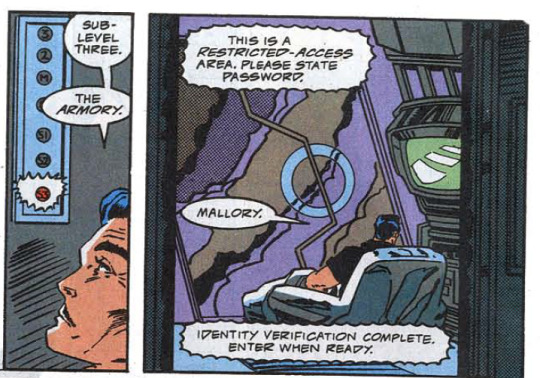
But in terms of actual publication order, this is definitely not the first time we have seen in canon that Tony is into Arthuriana, as I'm sure you all know. I would assume, in fact, that giving Tony a childhood interest in Arthuriana is because Doomquest is one of the most beloved Iron Man story arcs of all time, and that all started at least a decade before IM #287 here was published.
The villain of Doomquest -- the one who isn't Doctor Doom, at least -- is Morgan le Fay. Yes, that Morgan le Fay. Yes, Arthur's evil half-sister Morgan le Fay. Yes, all of this King Arthur stuff is canonically real history on Earth-616. Morgan's first appearance in Marvel, per the wiki, was in Black Knight #1 (1955), which I have not read, and judging by the summary I feel like this is probably just supposed to be a straight-up comic retelling of Arthurian legends for kids; I don't think Marvel really had the whole Marvel Universe in mind as a concept in 1955, so I'm not sure this was meant to connect to anything else. I feel like this is another one of those instances of Marvel discovering that they can write comics about characters in the public domain for free -- like, I'm pretty sure that's how we also ended up with, like, Norse, Greek, and Roman mythology wedged into 616.
As far as I can tell from the wiki, the first time Morgan tangled with the Avengers (or indeed the larger 616 universe) in any way actually predated Doomquest -- it was in an early arc in Spider-Woman (#2-6) and then Avengers #187, which came out in 1979, actually right when Demon in a Bottle was happening over in Iron Man comics. If you read #187, Iron Man is not in it because he's off the team due to his drinking problem and also his accidentally murdering the Carnelian ambassador problem. So Wonder Man's filling in instead. This issue is part of Michelinie's rather sporadic Avengers run, which makes sense, I guess, considering where we see Morgan next.
Anyway, Avengers #187 is the classic issue where Wanda is possessed by Chthon, but what you may not remember from Chthon's backstory (I sure didn't!) is that he was summoned by Morgan le Fay because she was the first person who tried to wield the Darkhold to summon him. As you can imagine, this did not work out especially well for her and her followers and they had to seal Chthon away in Wundagore Mountain, which was where Wanda found him. (The Spider-Woman stuff is only slightly earlier and also appears to be about Morgan and the Darkhold; the Darkhold is not one of the areas of 616 canon I am especially conversant with, alas. It's on my to-read list.)
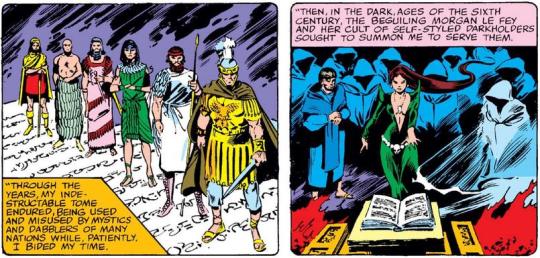
Doomquest, as you probably know, was a classic Iron Man two-parter in Layton & Michelinie's first Iron Man run that set up Tony and Doom as rivals; Doomquest itself was IM #149-150, in 1981, and then in their second IM run they came back and did a sequel in 1989, Recurring Knightmare (IM #249-250), and then the much later four-part sequel to that was the 2008 miniseries Iron Man: Legacy of Doom, which was also by Layton & Michelinie but generally does not seem to be as popular as the first two parts. They've all been reprinted, if you're looking for copies; I have a Doomquest hardcover that collects the first four issues and then a separate Legacy of Doom hardcover. Currently in the Iron Man Epic Collection line there's a volume called Doom, which confusingly only collects the 249-250 part of the storyline (as well as surrounding issues), because for some reason the first Layton & Michelinie run isn't in Epics yet but the second one is. So the beginning of Doomquest isn't currently in print, as far as I can tell. I'm sure you can find it anyway.
So what's Doomquest about? Okay, so you remember how Doctor Doom's mother's soul is stuck in hell for all eternity? Well, Doom's obviously interested in getting her back, and the strategy he has embarked on is to try to team up with other powerful magicians who can help him out, and he thinks Morgan le Fay would be a good choice, for, uh, his quest. Doom's quest. A Doomquest, if you will. (If you've ever read Doctor Strange & Doctor Doom: Triumph & Torment, you're familiar with the part where he later ends up waylaying Strange for this and they go to hell together. And if you haven't read Triumph & Torment, you really should, because it's amazing.)
So Doom is off to his time machine to go team up with Morgan le Fay and Tony thinks Doom is up to something -- Doom has been stealing components for his time machine from a lot of people, including Tony -- and he follows him and it turns out one of Doom's lackeys has a grudge and wants to trap Doom in the past forever, and Tony gets caught up in it. Now they're both in Camelot. Surprise! #149 is actually all setup; they don't get to Camelot until #150.
IM #150 begins with Doom and Tony thrown back into the past; there's a fandom-famous splash page of them locked in combat, only to realize that they have found themselves in Camelot.
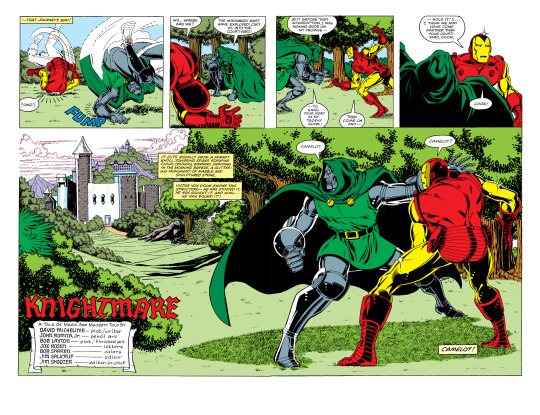
They are then discovered by knights; Doom would very much like to attack them, but Tony, who naturally would be happy to LARP Camelot forever, persuades him to play nice. Also Doom thinks Iron Man is only Tony's bodyguard so he keeps referring to him as "lackey," much to Tony's annoyance. Somehow everyone thinks they're sorcerers. Can't imagine why. The knights take them to meet King Arthur himself, and Tony has clearly had his introduction all ready to go, as he introduces himself in a timeline-appropriate manner, says he's here to apprehend Doom, and demonstrates his "magic" by levitating Arthur's throne. Doom's response is essentially "I'm the king of Latveria," which is, y'know, also valid. So they're guests at Camelot for the night while Arthur figures out what to do with them.
We then have a page devoted to Tony alone in his room, musing sadly about how alien he feels, how he doesn't know if he'll ever get home, how he could never fit in here without his beloved technology. Then a Sexy Lady shows up to keep him company for the night, and he decides maybe it's not all bad. Thanks, Marvel. I guess they can't all be winners.
Doom is using his evening much more productively; he compels one of the servants to tell him where Morgan's castle is, because he's still interested in having that team-up. Then he jets off. Literally. He has a jetpack.
The next morning Arthur's like "one of you is still here and one of you has punched a hole through the castle wall and flown off to join Morgan so I guess I know which of you is more trustworthy." He then explains to Tony who Morgan is, because Tony professes ignorance, because clearly we had not yet retconned in Tony's love of Arthuriana. Tony offers to go fight Doom and Morgan with Arthur; meanwhile, Morgan and Doom have teamed up and Morgan has offered to help get Doom's mother out of hell if he commands her undead armies against Arthur because for Reasons she can't command them herself anymore. So that's a thing that happens.
So, yes, it's Tony and Arthur versus Doom and Morgan. Fight fight fight!

Tony tries Doom first but then decides to hunt Morgan down, and in the ensuing fight we get what I think is Tony's first ever "I hate magic," a complaint that we all know he still makes even to this day.
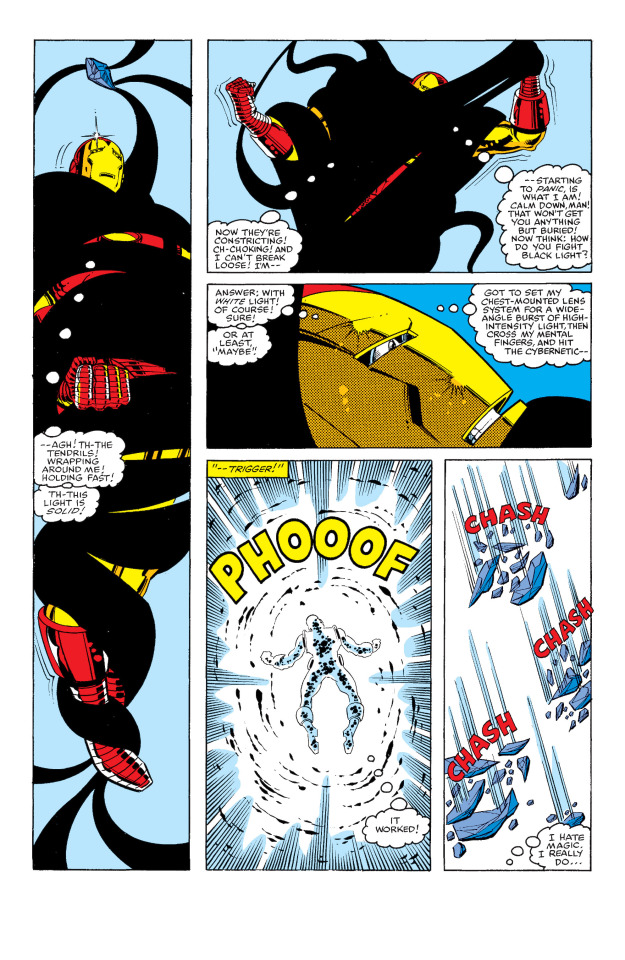
Anyway, Tony freezes a dragon with Freon (mmm, technology) and Morgan gets upset and disappears, so the battle comes to an end, and of course Doom is extremely mad at Tony because he blames Tony for Morgan not sticking around to save Doom's mom, because I guess Doom trusted her to keep her word? Weird. (Like I said, for the next chapter of Doom saving his mother, go read Triumph & Torment.)
Doom says if he and Tony work together, the components in both of their armors can send them both home. So Tony has to trust Doom. Which he does, because he really has no other choice. They build a time machine and Tony makes Doom agree to a 24-hour truce when they get back, so they can both get home. So it all works out okay, and they end up in the present, and Doom tells him, ominously, that they will meet again. Okay, then. That concludes the original Doomquest. It's fun! You can see why fandom likes it.
So that's all well and good, but you might have noticed that Tony's ability to get home hinged on Doom actually being trustworthy. And Doom was. But what if Doom hadn't been? What if he'd just stranded Tony in Camelot forever As you may have surmised from the form of that question, that is in fact a question Marvel asked themselves, because, yes, there's a What If about this! What If v1 #33 is "What if Iron Man was trapped in the time of King Arthur?"
The divergence point from canon, as you can probably guess, is the very end of Doomquest. Instead of Doom bringing Tony home, he deceives him and leaves him in Camelot. And since Tony cannibalized a lot of the tech from his armor to make the time machine, he doesn't have a way to go home.

This is not a story where Tony comes up with a way to go home after all. He really doesn't get to go home. But instead of drowning his sorrows in mead -- because, remember, Demon in a Bottle has already happened and Tony is sober now -- he decides he might as well just play the hand he's dealt. So with what's left of his armor, he defeats some enemies that Morgan rounds up to send against Camelot. And for his services, he's knighted. He is now Sir Anthony.
Tony acknowledges that he is both living the dream and would also like very, very much to go home.
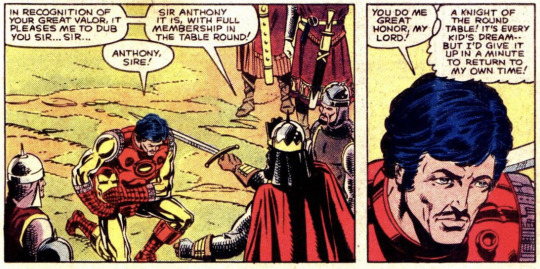
He does end up having some fun in Camelot; it's not all miserable. But he obviously doesn't want to be there.
So if you're at all familiar with King Arthur, you know how this goes, right? Arthur fights Mordred and Mordred kills him. And that does happen in this version. Except Tony is right there, and with his dying words, Arthur asks Tony to rule Camelot... and Tony agrees.
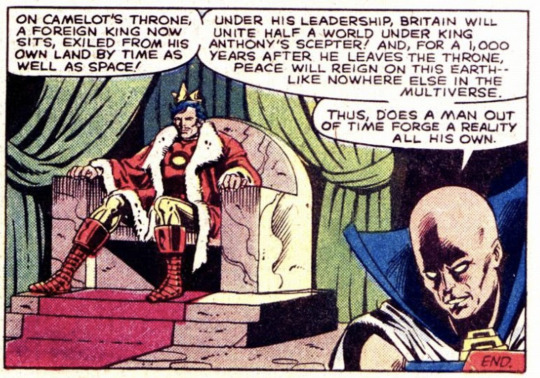
So, yes, Tony Stark becomes king of the Britons after Arthur's death and he never goes home again. The end. Man, I love What Ifs.
Heading back to main 616 continuity, there is still more of this arc to go. The original Doomquest was only two issues, yes, but it was popular enough that Layton & Michelinie did a sequel a hundred issues later, in their second run of Iron Man, and that's Iron Man #249-250, Recurring Knightmare. (In the intervening issues were Denny O'Neil's IM run, specifically the second drinking arc (#160-200), and then Layton & Michelinie came back and most famously gave us Armor Wars (#225-232). I would have to say that Armor Wars is definitely the standout fandom-favorite arc of their second IM run; for their first one, I think a lot of people would have a hard time choosing between Doomquest and Demon.) But anyway, yes. Recurring Knightmare.
Recurring Knightmare is... well, the best way I can describe it is "a trip." It is definitely a sequel to Doomquest, and it is also definitely not a sequel you would ever have expected to see for Doomquest.
Much like #149, #249 is pretty much just setup. Fun setup, but the big action is in the next issue. We open with Doom in Latveria, on his throne, pondering which of his servants he should have disintegrated. Anyway, he's just hanging out there when a mysterious object appears. In California, Tony is suited up and entertaining the crowd at a mall opening when the same object also appears! He takes it to his lab. Please note that this is after the Kathy Dare incident, so Tony is still recovering and is walking with a cane. Doom sees on the news that Iron Man has found the same object, which cannot be carbon-dated, and he shows up at Tony's house. He criticizes Tony's taste in art.
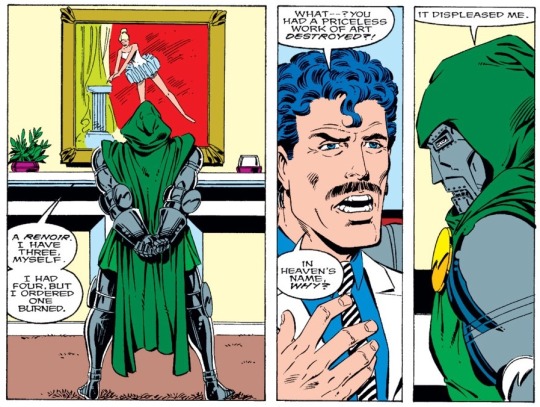
Anyway, Doom basically orders Tony to work with him. Tony refuses, and then Doom sends some robots to attempt to steal Tony's version of the object because he thinks if he has them both he will be powerful. Doom manages to steal it, and when he puts the pieces together, both he and Tony disappear.
So where do they go, you might ask? Camelot?
Not exactly. The future! There is a great callback to the Doomquest splash page.
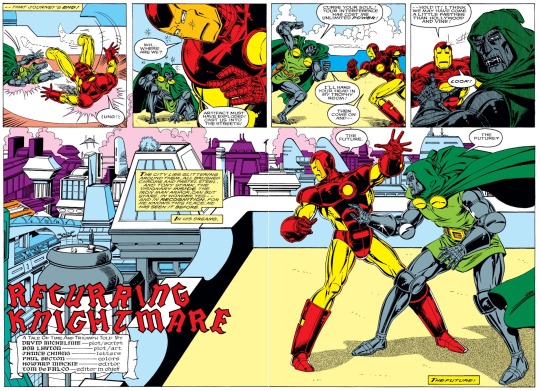
It turns out they are in London in 2093. Merlin brought them there. Tony still hates magic. And in the future, King Arthur is still there, except he is now a child, because he has been reborn. But he does remember Tony from Doomquest, at which point Tony kneels. Doom, of course, is not impressed. He asks why they have been brought to the future.
The answer is that things are going wrong in the future. If you do not personally remember United States politics in the 1980s, I need you to google the words "Strategic Defense Initiative" right now. I'll wait.
Back with me? Okay, so this is a future where Reagan's Star Wars program actually happened the way he wanted it to, and the satellites are still hanging around the Earth in the future and messing everything up, and Arthur and Merlin need Tony and Doom's help to stop them. Doom once again flies away with his jetpack, of course.
Tony is game to help, but he's not in an armor that can stay in space for long. This is when Merlin takes him and Arthur to the mall and Tony manages to get everything to upgrade his armor at Radio Shack. You see what I meant about this issue being weird.
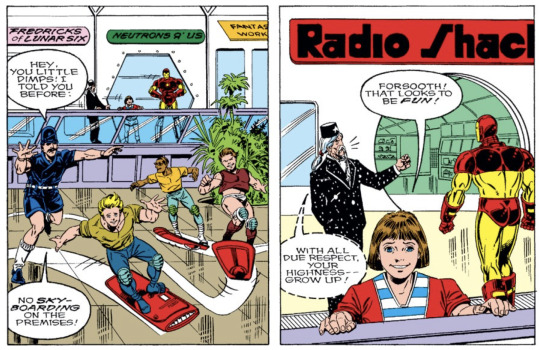
Tony is out in space trying to disarm the SDI platform, which is where he runs into his future descendant, Andros Stark, who is in armor you will probably recognize from Iron Man 2020. He is referred to as "the resurrected spawn of Iron Man 2020" so I assume he's actually directly related to Arno rather than a direct descendant of Tony; Wiki confirms that Arno is his grandfather. This is all from way before Arno was contemporaneous with Tony in canon. Anyway, he's fighting Tony.
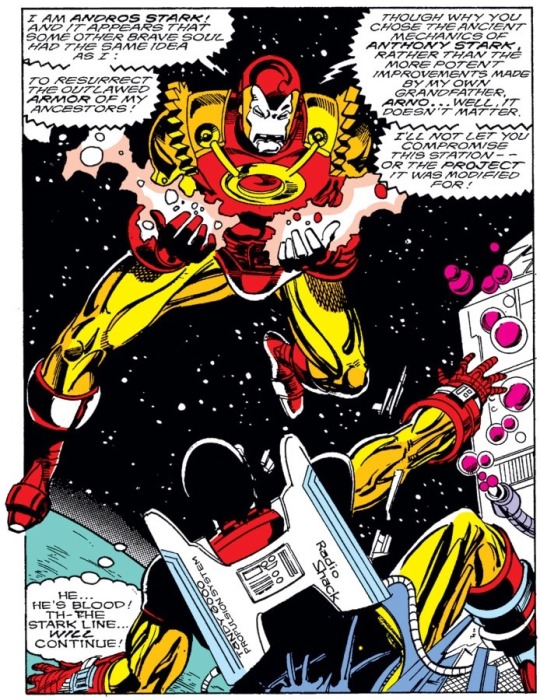
Oh, by the way, Future Doom exists. Future Doom would like to rule this future Earth and for some reason Andros would like to help him. Meanwhile, Present Doom finds out from Merlin that he can't leave except by magic and he can't leave without Tony, so he is reluctantly on Tony's side.
They need help from the Lady of the Lake, except the lake has been paved over and is now a parking lot. Merlin makes the lake come back and then of course they get Excalibur. Arthur is a kid, so he can't wield a longsword; Doom assumes he's going to take it because he is basically a king, and he's pretty grumpy when the sword picks Tony. Tony then uses Excalibur to destroy the space lasers, and I bet that is a sentence you never thought you would read. It's pretty cool. Tony concludes that magic has its good points. Tony stops Andros and Doom stops, uh, himself, and the world is saved and they get to go home. Also, Doom finds out Tony is Iron Man, but when Merlin sends them back he conveniently erases their memories, so neither of them remember anything about this and Tony's secret is still safe. And that's the sequel to Doomquest.
And if you think that's weird, wait until you see Legacy of Doom.
Iron Man: Legacy of Doom is a four-issue miniseries from 2008, also by Layton and Michelinie. Even though it's from 2008, it's set during a much more classic time in Iron Man, continuing on from where we left off in this Doomquest saga. We start with a framing story in 2008. Tony, who has Extremis now, is busy scrapping some of his older armors and reviewing his logs when he suddenly remembers that there was a whole thing with Doom that happened that he seems to have forgotten about until right now. So the whole thing is narrated by Tony in flashback.
Tony's in space fixing a satellite when a hologram of Doom shows up and summons him to Latveria. It's not really clear why Doom needs Tony's help in particular here, but Doom tells Tony that he's discovered that Mephisto would like to bring about the end of the world, which Doom finds, and I quote, "presumptive." So Doom has his Time Cube, and with it he takes Tony to hell.
(Yes, I promise this is relevant to Doomquest. There will be some Arthuriana shortly.)
Doom brings Tony to Mephisto, and it turns out it's a setup! Doom trades Tony for an item he wants from Mephisto, leaves, and Tony's going to be trapped in hell forever! Oh no! (I mean, he's not. But it's quite a cliffhanger.)
At the beginning of issue #2, we find out what the Arthurian connection is, which is that we learned that after the events of Doomquest, Morgan had been granted sanctuary by Mephisto in exchange for a shard of Excalibur that she had somehow stolen. Doom still wants Morgan's help with some magic -- he doesn't mention what it is here, but he says he needs someone of Pendragon blood, and that'd be her -- so he traded Tony to Mephisto in exchange for, I'm guessing, Morgan and the Excalibur shard.
I have probably mentioned this elsewhere, but Legacy of Doom #2 is one of my favorite issues of Iron Man ever, solely because of the next scene. We return to Tony in hell. Howard Stark is also in hell, and he is now a demon, and Tony has to fight him. Mephisto brings popcorn and watches. This is the one time in canon when Tony actually confronts his father, and okay, yes, it's a fistfight in hell and Howard is a demon, but that's comics for you. Howard spends several pages insulting Tony -- specifically insulting his masculinity, but that's a whole other essay -- until he finally insults Maria too, and that's when Tony fights back, because his mother taught him to be good. Honestly if you're a Tony fan I'd recommend this issue just for that scene.
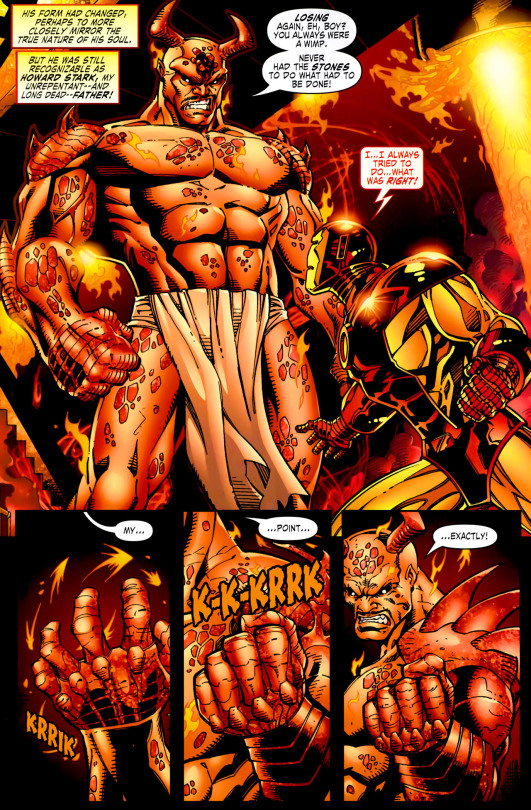
Anyway, we go back to the Doom and Morgan plot, and Morgan casts the spell Doom wanted, which was fusing the Excalibur shard with Doom's armor. Then Doom sends her back to Camelot rather than hell, because he's still mad that she never helped him get his mom out of hell like she said she would.
Tony freezes Howard with Freon -- yes, the same trick he pulled on the dragon back in Doomquest -- and tells him, "You're no father of mine." It is immensely satisfying.
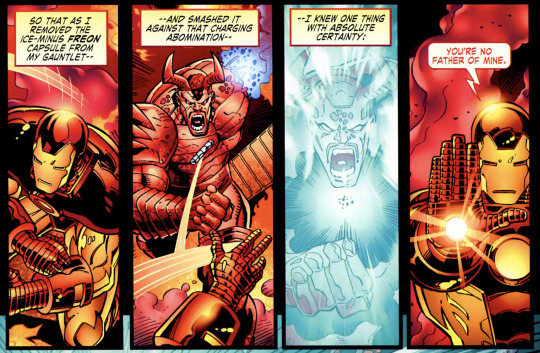
(I had been going to mention that I thought it was a shame that neither canon nor fandom seems to have really engaged with this confrontation, and I know canon never believes in narrative closure but fandom sure does -- and then, anyway, it occurred to me that since the framing story of Tony remembering this is set when Tony has Extremis, there's a very good chance that he no longer remembers remembering it. Goddammit, Marvel.)
(If I got to retcon one canon thing about Tony, I think "the entirety of World's Most Wanted" is up there. I mean, okay, a lot of things are up there, but WMW is definitely on the shortlist.)
Okay. Tony has now engineered his way out of hell, and he's back with Doom in Latveria. Doom has Excalibur. Doom would very much like to fight him. While wielding Excalibur. You get the sense that this is going to be bad. Another cliffhanger!
Legacy of Doom #3 opens with Tony destroying Doom's lab to buy time and running away from Doom and Excalibur. I should probably mention that Doom still doesn't know Tony is Iron Man (anymore), so he thinks he is dealing only with Iron Man, Tony Stark's lackey. Meanwhile, some scientists at SI think there's something weird going on with space. Meanwhile meanwhile, Tony is in a forest taking a breather when a mysterious old man walks up to him.
It's Merlin! Surprise! Merlin wants Tony's help to stop Doom from doing whatever he's doing with Excalibur. The sword makes you invincible and the scabbard makes you invulnerable, so Merlin sends Tony to Scotland on a fetch quest for the scabbard. Doom has now magically sent the sword in search of the scabbard, so the sword flies away to meet it and Doom follows. Turns out the thing that's wrong with space is a thing that's going to hit Earth at the exact place Tony and Doom are. What a coincidence! So Tony and Doom get trapped in a stone circle and fight some stone warriors and then Tony ends up with the scabbard. And by "ends up with," I mean it fuses to his armor. Next issue!
Legacy of Doom #4 is when things really, really get weird. A giant demon made of eyes (???) appears, and this demon is apparently what Doom had been preparing to fight (because it's mad that Doom stole one of its spellbooks), and now he can't, because the sword and the scabbard aren't together. Thanks, Shellhead.
That's when Merlin shows up and says all is not lost. They can defeat the demon... if they put the sword into the scabbard.
"But I'm the scabbard now!" Tony says, uncomprehending.
"Yes," Merlin says. "You are."
Then Tony gets it.
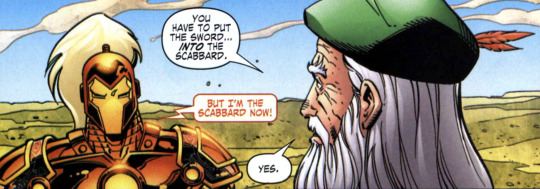
So, yes, Doom has to, um, penetrate Tony. With Excalibur. I love comics. I love comics so much.
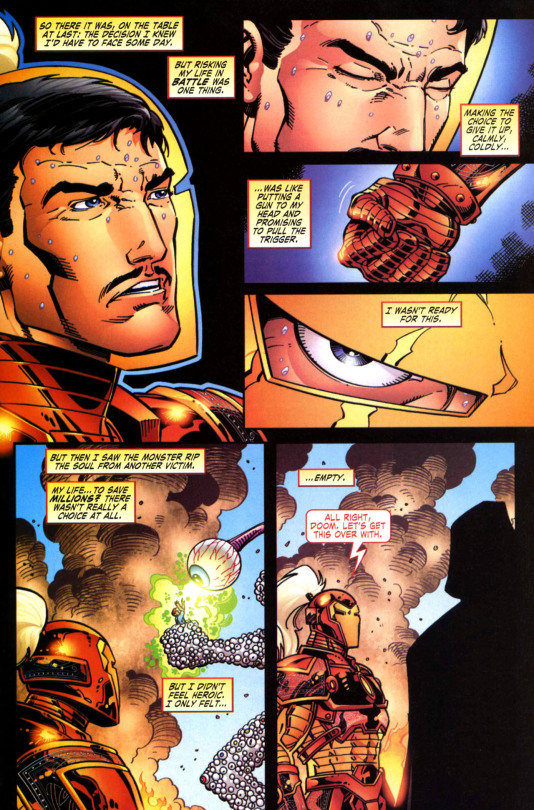
So that's a thing that happens.
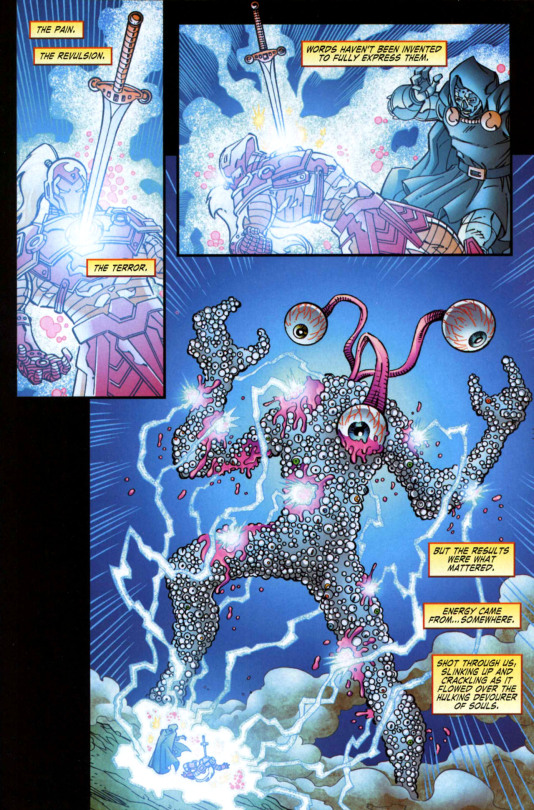
And then Tony flies off and, I guess, resolves to never, ever think about any of this again.
We head back to the framing story, in which Tony, now having remembered all of this, flies to Britain, buys the land the lake is on, and paves it over, presumably so it will be there for Merlin to bring back in Iron Man #250. The end.
Whew.
Okay, yeah, I know I didn't have to summarize the whole thing, but Legacy of Doom here really is one of my favorite Iron Man miniseries. And I just want to share the love. Please read it. It's great.
But the Arthuriana fun doesn't end there! In fact, now we get an Arthurian-themed arc that actually isn't in Iron Man comics. It's in Avengers! Iron Man is involved, though.
(There is also apparently a Morgan arc in Avengers #240. I actually haven't read it. It seems to be yet another Spider-Woman arc. I get the impression that this isn't really Arthuriana other than having Morgan in it fighting Jess, though, so it doesn't seem quite as relevant. Morgan also apparently has some appearances in FF, Journey into Mystery, and Marvel Team-Up, but those seem like more of just basic villainy. Also, probably not involving Tony.)
Kurt Busiek's 1998 Avengers run, volume 3, is in large part the kind of Avengers run that is a nostalgic love letter to older comics. Heroes are heroes and villains are villains and good triumphs over evil. The Avengers all live in the mansion and are BFFs. I love it. It does assume that you are already a fan of the Avengers, because it starts out by summoning pretty much everyone who has ever been an Avenger and is available to the mansion, and that is... a lot of people. Thirty-nine, by my count. Also, when the entire team is magically whisked away, we are treated to the following narration, as Steve disappears: "And Captain America's last thought, as the world goes white around him, and he with it -- is that Iron Man would hate this."

The narration doesn't tell you why Iron Man would hate this, or how Captain America would know that Iron Man hates this. This is not explained later on. But if you have read comics -- or if you have read the above summary of Doomquest -- you know that Tony is absolutely, one hundred percent, thinking, "I hate magic." And Steve knows it.
The reference is not relevant to the plot; if you don't get it, you'll be fine. But that's what I mean when I say this is a nostalgia run. There are definitely Easter eggs for people who have read a bunch of comics. Busiek does this a whole lot in his work -- there's a reason you can buy an annotated edition of Marvels -- and, yeah, it happens here too. Just know that there will be references you're not getting, if you're new to comics.
Anyway. So Busiek's run actually starts out with an Arthurian arc, #1-4, "The Morgan Conquest." The name is a dead giveaway. Yes, Morgan le Fay is back. Again. For once, Doom is not involved.
The Avengers are all back from their sojourn on Counter-Earth after fighting Onslaught -- don't worry about it -- and mysterious things are happening. There are a lot of monster attacks. So pretty much everyone who has ever been an Avenger is summoned to the mansion, at which point we learn from Thor about some mystical artifacts that are being stolen. (They are the Norn Stones and also the Twilight Sword. That sounds like something from a Zelda game, doesn't it?) The Avengers go to try to stop this, end up in Tintagel, and then they run into Mordred. He wants to capture Wanda, presumably for Magic Reasons. Morgan le Fay casts a spell on all of them, reshaping reality. Yes, all of them. Surprise!
So now all the Avengers are living in a medieval castle and/or town; Morgan is their queen, and thanks to the power of mind-control they are all basically living in Ye Olden Times. The Avengers are all some variety of knight, except for Wanda, who is chained up in the dungeon so Morgan can steal her magic and use it to fuel all this reality-warping.
Wanda calls for help, and that snaps Steve (Yeoman America!) out of the mind control (or altered reality or whatever you want to call it) pretty fast, because Steve's always been very good at resisting mind control, and then Steve promptly goes and snaps Clint out of it, because I guess Steve is also good at inspiring people to snap out of mind control. "Oh, man!" Clint says. "Not another alternate reality! Not again!" (I assume he's referring to Counter-Earth? Maybe?)
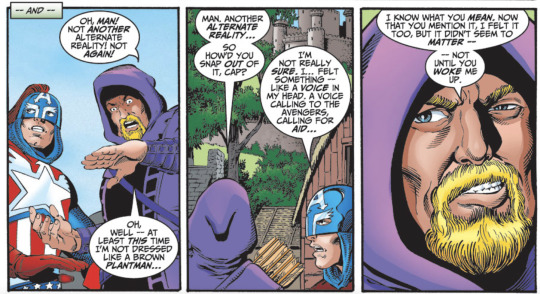
So Steve and Clint go around reassembling the Avengers and orienting them as to reality. They get Jan and Monica easily, but then Steve insists on trying to get Tony because, I guess, he likes Tony and would really like to hang around Tony, who is half-naked and asleep in his bedroom, and certainly I am reading nothing whatsoever into this. Clint tells Steve it's not going to work. Tony has historically been fairly susceptible to mind control; it was only pretty recently at this point that he'd been doing Kang's bidding in The Crossing. But the more serious impediment is that this is Tony Stark and he would obviously like to LARP being a knight forever and ever. Tony, therefore, does not believe Steve, and throws him and Clint out of his bedroom and into the barracks.
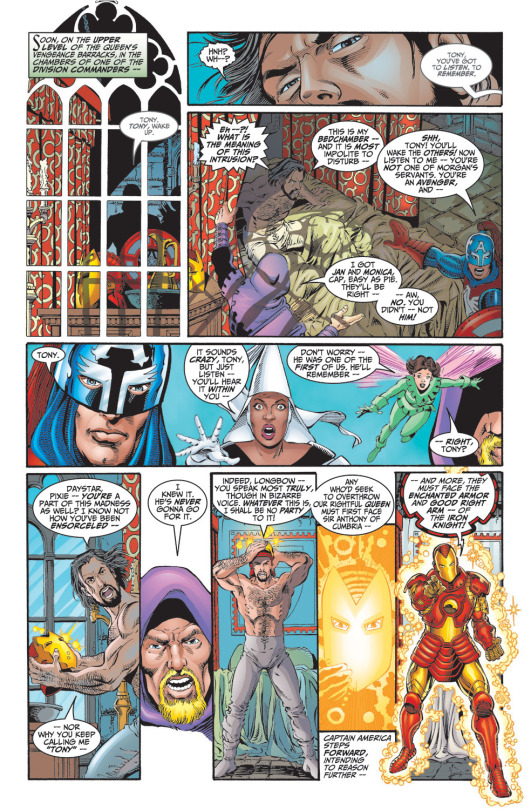
"Iron Man's a good guy, normally," Clint says. "But he's waaay too into his whole nobleman/lord of the manor trip. That spell musta hit him right where he lives!"

Clint speaks the truth, clearly.
Anyway, they go around and manage to make pretty much every Avenger in the room other than Tony snap out, and attempt to rebel against Morgan while Tony is stil fighting them because he is Still A Knight. There's a lot of punching, because some of the Avengers still aren't free; they weren't ones Steve found.
The day is saved when Wanda manages to channel Wonder Man and break free. This gives the Avengers a fighting chance against Morgan and the Avengers are all lending Wanda their power when Tony finally snaps out of it and is on the side of good.

Then they take Morgan down, go home, and attempt to figure out which of these thirty-nine people should be on the active Avengers team. Hooray.
But that's not the end of Morgan le Fay showing up to screw around with Tony's life! There's more to come! Not much, but there is one that I know of, and at least one more memorable reference.
(I haven't read all her appearances or anything, but one of them definitely involves Tony; I can't swear that he doesn't appear in any of the other books Morgan shows up in, but it'd be a cameo for him, because I only know of one more arc that she's in in a book that Tony stars in.)
In a few more years, we have now entered the part of Marvel Comics history where Brian Michael Bendis writes all the Avengers books at the same time for, like, seven years running. It was sure A Time. There were a lot of word bubbles.
And the thing about Bendis is, Bendis looooooves Doomquest. If you're familiar with the very end of his tenure at Marvel where he made Doom be Iron Man after Tony got knocked into a coma in Civil War II, you have probably figured out already that he likes Doom. But he also likes Doomquest, specifically.
I mean, if nothing else, the giant splash page in The Confession where Maleev redrew the climactic Doomquest fight while Bendis had Tony talk about how deeply meaningful to his understanding of the world this all was -- and how it allowed him to predict Civil War -- was probably a big clue, right?
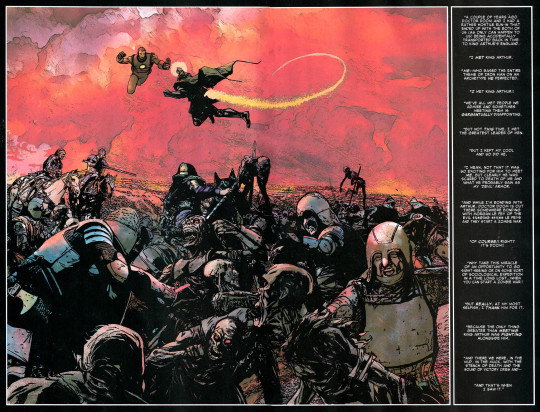
As far as I am aware, Morgan le Fay makes exactly one more appearance in Tony's life. And that's in Mighty Avengers vol 1 #9-11. Only one of those issues is named, so I'm going to assume the arc is named after it: Time Is On No One's Side.
You remember Mighty Avengers, right? The deal with the Avengers books at the time was that after Bendis exploded the mansion and made the team disband in Avengers Disassembled, the main Avengers book was no longer called just Avengers. Instead, the main Avengers book was New Avengers, and that was the only Avengers book. Then Civil War happened, Steve got killed, and New Avengers became the book about what was left of the SHRA resistance (i.e., Steve's side) after the war. So about halfway through New Avengers, Mighty Avengers starts up, and Mighty Avengers is about an extremely fucked-up and grief-stricken Tony Stark trying to run the official government-sanctioned Avengers team, with Carol's help. This is the comic with the arc where Tony turned into naked girl Ultron. You remember.
So, anyway, there's this Mighty Avengers arc where Doom is Up To Something (there are symbiotes and a satellite involved) and somehow Tony and the Avengers end up in Latveria, punching Doom. Also, by the way, Doom is visiting Morgan in the past because he likes her. The Avengers attacking his castle made him have to come back to the present, so he's kind of cranky. And he fights Tony, and in the course of the fight, his time platform explodes and sends Doom and Tony and also the Sentry to... the past.
This is one of those times where you should definitely look up the comics if possible because the way the past is visually indicated here is that it's colored with halftone dots the way you would expect old comics to be colored, although they have modern shading and color palettes. It's very charmingly retro.

So the three of them are stuck in New York in the past, and naturally they would like to leave. There's one person in this time who has a time machine and it is, of course, Reed Richards. Doom and Tony have a lot of banter in this arc; I think it's entertaining.

Sentry has to be the one to break them all into the Baxter Building because of that power he has where no one will remember him. So they do that, travel forward in time, and end up in Latveria in the present again except Doom is gone and also things are currently exploding where they are.
Doom, of course, has made a side trip to visit Morgan again and he asks her to help him build an army, because I guess this is what their relationship is like. So the rest of the Avengers are captured by what look to me like Mindless Ones and are in a cave in magic bondage, because comics. Jess comments that at least they aren't naked, because she too is remembering that memorable New Avengers trip to the Savage Land. Doom threatens Carol in some creepy sexist ways and eventually it turns out that Tony and the Sentry are fine and everyone kicks Doom's ass. Business as usual.
And the last page of the arc is Morgan alone, wondering where Doom is. So technically Morgan and Tony don't come face to face here, but I think she counts as being at least partially responsible for ruining Tony's day here. And then Secret Invasion happens and Tony has a very, very bad day.
There are a few more Morgan appearances after this, but, as I said, I don't think any of them involve Tony. She shows up in Dark Avengers, apparently, which was one of the post-Civil War Avengers titles I didn't read, and I know that recently, on the X-Men side of things, she's been in Tini Howard's Excalibur one, which I have only read a little of. No Tony there. Just a lot of Morgan and Betsy Braddock and Brian Braddock and the Otherworld.
If you are interested in Morgan's other appearances, you might like this Marvel listicle that is Morgan le Fay's six most malicious acts. I pulled some of the Darkhold backstory from their discussion, but it's not really focused on Morgan and Tony.
So there you have it! That's everything I know about Tony's love for King Arthur and every run-in I know about that he's had with Morgan le Fay! One of two terrible people in Tony's life named Morgan! Actually, I don't think we've seen Morgan Stark in a while. I wonder if he's alive. There should be a Morgan & Morgan team-up. I should probably stop typing and post this.
The tl;dr point is that you should all read Doomquest and its sequels, especially Legacy of Doom. They're great!
63 notes
·
View notes
Text
OnS Theories (24S). Second Theory - Explanation of the Memory Segment and the World of Illusions.
Hello everyone, finally we start with new theories, and I must say, chapter 106 just rocked. It was a really well done chapter, sasuga Kagami-sensei!
Nevertheless, there have been many doubts surrounding it, specially one about Mika and Shikama appearing, which actually have a more simple explanation than what it looks like, therefore, let’s begin!
P.S: Theories are held within neutral view and ships are excluded
https://www.youtube.com/watch?v=Js0bL1jOjeY
Before I start up explaining how this memory segment and the illusions work, let’s make a review or recap of the chapter:
First of all, the chapter resumes were Mikaela saw the big eye in the darkness; of course, such eye represents the depthness within Yu’s heart, as to why, I’ll explain that later on, but nevertheless, he noticed something peculiar about such eye:
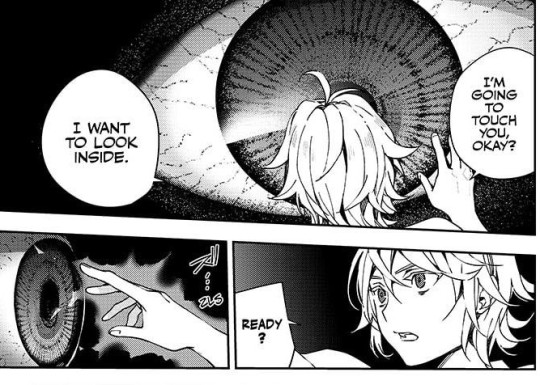
Image taken from Seraph of the End: Vampire Reign - Chapter 106
He was aware the eye meant no harm to him, thus leading him to touch it, which of course, the eye gave permission to him, but why?
The reason to this is very simple; despite the eye which in fact is Yuu’s heart, or the source of origin of Yuu; the memories and experiences that have been withstood within Yuu along being engraved deep within his very soul remain there, thus meaning he trusts Mika completely, knowing he does not mean any harm along the very fact that he does see him as an equal, a human to the very core.
After this, the memory segment begins.
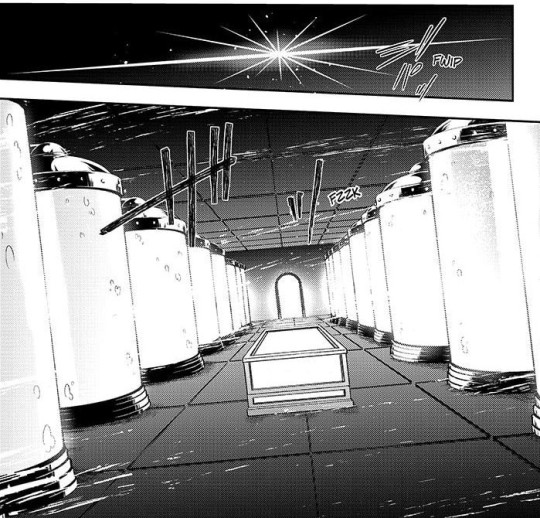
Image taken from Seraph of the End: Vampire Reign - Chapter 106
But, is this truthfully a memory segment?
The answer to this is absolutely yes.
You might wonder where or how exactly this is possible, and for that, I’ll bring the biggest reference possible to this kind of scenario and that is the franchise of Assassin’s Creed.
For those who might not know, Assassin’s Creed is a game franchise which of course, focuses on a secret order that works in the shadows to keep balance in the world against Templars, but of course, the main point or comparison is that the game itself uses memory segments, what do I mean?
The MC within those titles, uses a special machine to experience and live in a simulation the memories of their ancestors...
Along this, another anime that uses such events is actually a bizarre anime that I do not recommend to watch, which is Corpse Party. (Warning: Do not watch unless you tolerate horror and gore)
Within said anime, there’s a scene on which one of the main cast gets to experience lively what happened to the unfortunate souls that were living in a constant grudge to their tragic past. Which this could relate as living a memory segment as well...
And this is precisely what happens with Mikaela after touching said eye. ,it could be said he is set into a world made of the memories the very origin of Yuu experienced in flesh, which is why the next panel goes like this:
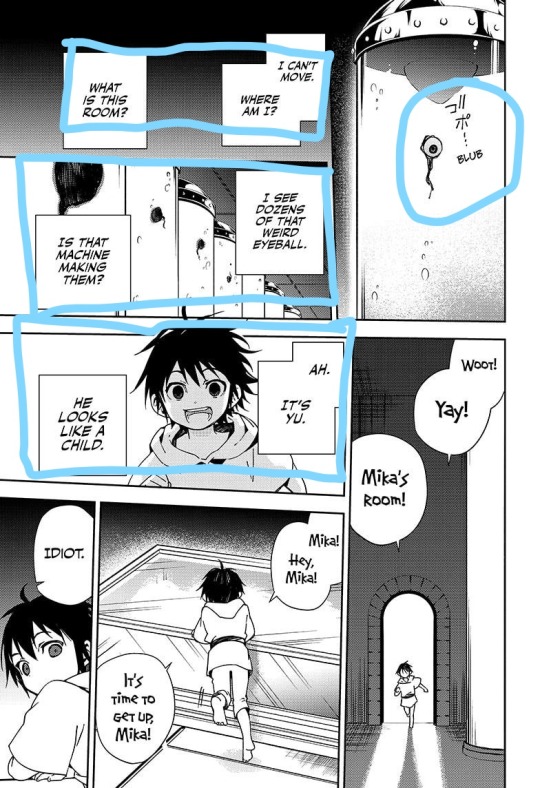
Image taken from Seraph of the End: Vampire Reign - Chapter 106
In the picture above and my failed attempts to trace a circle, the one looking at everything is in fact Mikaela Hyakuya; which is why he asks about where he currently is, along the creepy eyes in the tanks along spotting a child which is Yuu, the one that lived in with the progenitors and the chosen apostles.
It could be said that the big eyeball that allowed Mikaela to touch it, displayed Mika the distant past, along letting him experience everything in flesh, which is why he took the form of the tiny eye watching everything including Yuu.
Following this, Noya arrives and spots Yuu, which of course, knowing Yuu’s nature, he’s quite happy and hopeful to awake Mika without the knowledge of knowing that, in order to awake the corpse, he needs to disappear, but of course, knowing Noya’s nature, he stops being tolerant with him and decapitates him in the act:

Image taken from Seraph of the End: Vampire Reign - Chapter 106
Of course, to the scene, Ashera arrives and tells Noya that he shouldn’t have done that since Sika Madu would take heed and notice the incidents going around. (To this point, the memory segment is normal.)
This follows up Noya into saying that he’ll create another:
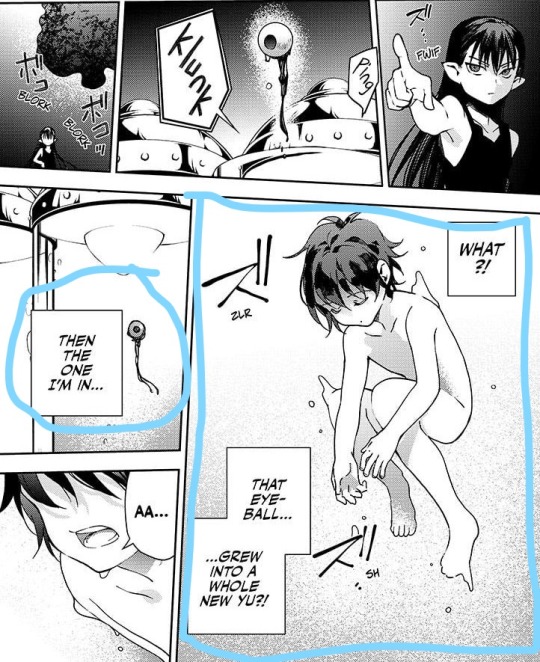
Image taken from Seraph of the End: Vampire Reign - Chapter 106
Within the circled dialogue box and the eye floating which of course is Mikaela, he notices that from the eyes that were floating in those tanks, they instantly materialized Yuu which of course was bestowed with life once it was out of the tank.
But since Noya couldn’t tolerate how noisy the cloned Yuu was, he ended up killing the newborn clone, thus leading to Mikaela’s position:
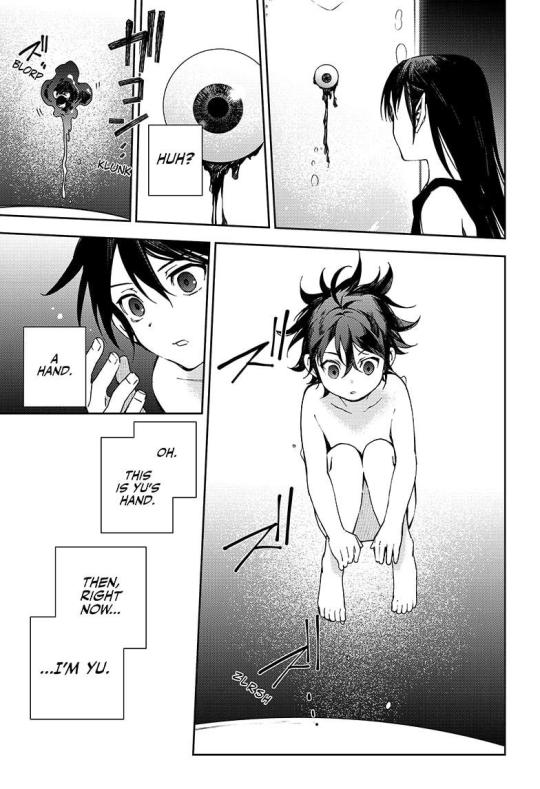
Image taken from Seraph of the End: Vampire Reign - Chapter 106
Mikaela realized he’d get materialized as Yuu and by experience, understood that if he made a noise, he’d get killed:

Image taken from Seraph of the End: Vampire Reign - Chapter 106
But now, the biggest question comes, which one could it be?
How was Noya not able to detect the changes and why did this memory segment continued? Does it mean the memory segment continued normally?
Within this, there are two scenarios:
First Scenario - The Past Simply Repeated Itself
Within this First Scenario, it’s very likely that the next clone made of Yuu wasn’t killed, which of course paints very well as to why Noya didn’t do anything else like ejecting or killing the current clone standing
Second Scenario - The Memory Segment didn’t consider such action as a huge alteration of the events
Within this scenario, which is likely just like the first one, it implies that the memory segment wasn’t affected that much, which is why it didn’t get destroyed or ejected Mikaela from it, since sooner or later, the next part of the segment would replay leading the events of seeing Shikama and the other demons arriving to the scene, and the biggest proof to this is the next panel:
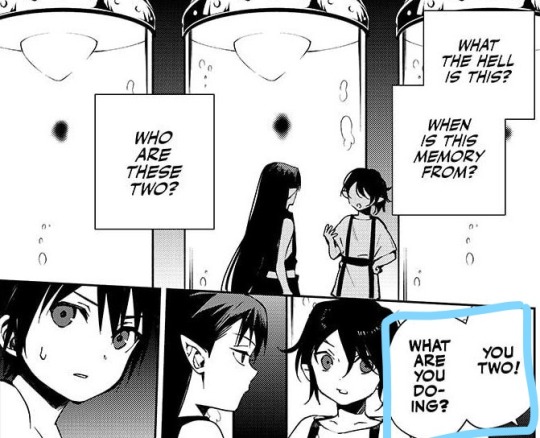
Image taken from Seraph of the End: Vampire Reign - Chapter 106
After Noya and Ashera stopped paying mind to the clone of Yuu in there, Mikaela managed to wonder who they were and where exactly such events took place, thus leading to the arrival of the other demons which, until that spot, was where the memory segment was going or replaying:
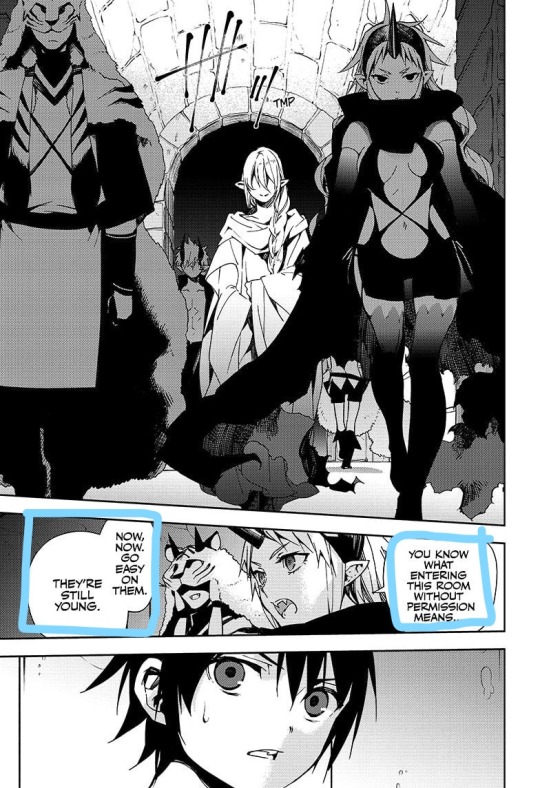
Image taken from Seraph of the End: Vampire Reign - Chapter 106
When the other demons arrived, the memory segment was slowly getting disturbed by something, but what could this something mean?
Correct. The Power of Illusion and Distortion
The First Progenitor is well known to have powers that are equivalent of those to a God; powers that are extremely powerful to invade whatever he wishes to do, but, within this, the First Progenitor hasn’t even considered that within his schemes, there’s already a Trojan Horse invading his plans since the First Progenitor pretty much underestimates everything around him due to his arrogance which is why Rigr uses this disadvantage of the First to execute his plans without his notice:

Image taken from Seraph of the End: Vampire Reign - Chapter 106
Once Rigr finishes the countdown, the First Progenitor manages to fully materialize within the Memory Segment but, how is that possible?
Since the First Progenitor is capable of invading other’s hearts, which is heavily seen within chapter 73:

Image taken from Seraph of the End: Vampire Reign - Chapter 73
Back in chapter 73, Shikama managed to infiltrate in Ashera’s heart with ease, without alerting Yuu about it, since he was pretty much focused on making Ashera remember their agenda and goals to fulfill which lead to the current present.
But returning to the main theory, how exactly does this revolve around the powers of illusion and distortion?
For this, it is needed to understand that the memory segment acts like a Lucid Dream, which can be defined as this:
Lucid dreams are when you know that you’re dreaming while you’re asleep.
You’re aware that the events flashing through your brain aren’t really happening. But the dream feels vivid and real. You may even be able to control how the action unfolds, as if you’re directing a movie in your sleep.
Link source: https://www.webmd.com/sleep-disorders/lucid-dreams-overview
This only gives strength as to why Mikaela was capable of changing few aspects without distorting the events of the past, but, since both Yuu and him lowered their guards, the First Progenitor had a door, but which one?
Correct. Asuramaru
After Asuramaru saw the transformation of the vampire Mikaela into a demon, he was able to remember everything, including how he became an apostle to Shikama and his loyalty towards him.
His main task is to serve him and retrieve Mikaela’s soul but since he was forced to obey Yuu due to the laws of the contract, the only thing Asuramaru might have been able to do is allow Shikama Doji enter within his heart, allowing him to fully enter into the heart of Yuu which was left wide open.
Thus leading to the next event, which is, creating an illusion, what do I mean?
After he managed to enter into Yuu’s heart or rather the deepest part of his heart, he mixed himself within the memory segment, allowing the segment to continue until he reached a safe distance where Mikaela was present, what do I mean?
This could be described as him acting as a part of the memory segment, but, instead of showing the memory of Sika Madu; he exchanged that memory figure with him, which could be single defined as substitution.
Which is why once he got close to Mika, the next thing that happened was this:

Image taken from Seraph of the End: Vampire Reign - Chapter 106
The Sika Madu displaying there isn’t the one from the past, but in fact, it’s the current Shikama Doji wearing a disguise and this is heavily seen by how he was able to manifest the scythes he currently uses as a demon; hence why he states he didn’t expect Mikaela would come that far to the past, and this is actually due to the fact that Mikaela wanted to understand why Yuu was that way and what he was mixed into, thus leading to the next panel:

Image taken from Seraph of the End: Vampire Reign - Chapter 106
Mikaela realizes that the real monster managed to appear within the memory segment or lucid dream he was experiencing since he heavily states that he has to wake up and get out of there.
But within this, there’s something rather curious that many readers within the spanish and english fandom wonder, what could it be?
What does Shikama mean by not letting Mika get away again?
That’s actually easy, what do I mean?
If many might recall, in chapter 98 Shikama made an act of presence in order to retrieve the demon Mikaela by sending Asuramaru, Gekkouin and Kiseki-O to his wolrd, which, they almost managed to capture:

Image taken from Seraph of the End: Vampire Reign - Chapter 101
Of course, what they didn’t consider was the fact that Yuu was heading their way to save Mikaela, which is why the First Progenitor is doing the job himself:
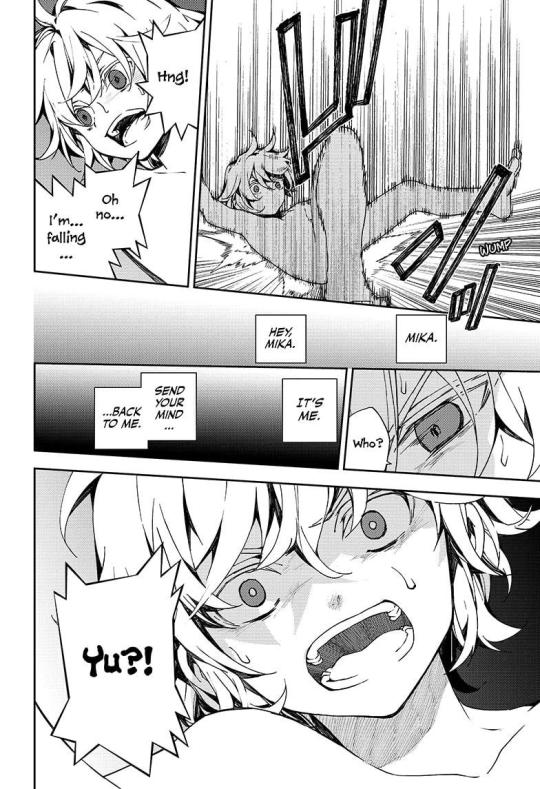
Image taken from Seraph of the End: Vampire Reign - Chapter 106
Of course, due to the massive difference of power, Mikaela isn’t capable of defending himself, but, within this, there’s something huge to highlight, what could it be?
The current Demon Mikaela isn’t tied to Shikama Doji
What does this mean?
It means that the demon Mikaela is made of all the life experiences and memories Mikaela Hyakuya lived, it means the past he had is the one he lived, BUT, the very reason the First Progenitor targets his soul it’s because he needs a soul to bring back whatever he wants to bring which of course it’s not good news.
Once he gets Mika’s soul, Mika and Yuu will cease to exist.
Which is why, the next thing that happens is this one:

Image taken from Seraph of the End: Vampire Reign - Chapter 106
Yuu goes to his rescue as a voice; he reminds Mika that he’s not alone but in order to save him, he needs to accept the deal and contract of becoming his demon, so he can get more powerful and finally fend against the monster Shikama Doji truthfully is.
With this theory, it is focused to explain the events that happened in the latest chapter.
Hope this theory solves the many doubts the fandom may have!
Hope you enjoyed reading this!
What do you think dear readers?
Let me know!
#owari no seraph#seraph of the end#sote#ons#ons theories#ons theories 24th season#second theory#ons chapter 106 spoilers#ons chapter 106#demon mikaela hyakuya#mikaela hyakuya#mikaela shindo#yuichiro amane#yuichiro hyakuya#noya hienma#noya#asuramaru#ashera tepes#kiseki-o#byakkomaru#raimeiki#gekkouin#shikama doji#sika madu#ons chapter 101#what do you think dear readers?#Let me know what you think#ons fandom#ons doubts and answers#reference to assassin's creed
74 notes
·
View notes
Text
Reiki and Appropriation

For a while now I’ve been wanting to make a post about Reiki, and I thought what better topic to talk about then how it both appropriates and is appropriated! I’m more or less gonna break this down into sort of a Q&A style, and talk about the different issues that surround the practice currently.
1. Why is Reiki considered a closed practice?
The main reason is less due to the cultural influences that surround it and more about the culture of the practice itself. For those who are unaware, in order to practice Reiki, you must be “initiated” by a Reiki Master. Part of this involves an attunement process, where the teacher matches your energy frequency to that of the earth. This attunement can happen more than once, but it allows you to tap into the Reiki energy that exists within the energy field around you.
2. This sounds similar to just energy healing. Why can’t I perform Reiki then?
You can’t perform Reiki not because it is morally/ethically wrong or because there is a history of oppression/misinformation surrounding the practice(though there is a lot of the latter), it’s simply because you literally cannot do it. You are not capable of doing it yourself without the attunement. Sure, you can do any sort of energy healing without having to be attuned, but to Reiki specifically without the initiation is not possible.
3. Then how did the first Reiki user learn to use it?
To make a long story short, the first Reiki Master(Mikao Usui) learned Reiki through his studies as a Buddhist monk. He became attuned through both his meditations and through higher powers giving him the attunement he needed. So, if you’re a very spiritual/religious person and you ask whatever higher powers to attune you, I suppose you could do that if you really wanted to!
4. But I've read so many books that claim you don’t need to be attuned!
I hate to break it to you, but a lot of those books are lying. I know, crazy!
The reason this started to happen was due to the rise in New Age witchcraft and spiritualism over the past couple decades. They not only incorporated their own forms of appropriation/misinformation(introduction of chakras and auras, “Christian” origins, equating it to manifestation, etc.), but they watered it down so aggressively to make it accessible to anyone. This includes the claims that you don’t need to be attuned to practice Reiki.
Some “teachers” also don’t really care about the sacredness of the tradition and view it more as a commodity that they can throw out to unsuspecting individuals to make money on. Not everyone is like this(my teacher certainly wasn’t), but unfortunately a lot of people view Reiki as a way to spew problematic and unhelpful crap and completely derail what otherwise is a sacred, meaningful practice.
5. Ok, but I still want to practice Reiki!
If you truly believe Reiki is your calling and you’re willing to put the effort in, find a Reiki Master in your area and take those lessons! I’d recommend learning in person, as I found the experience to be much more personal and more effective. Make sure you do your homework and find a quality Reiki Master, as unfortunately there are a lot of scams out there, or people who will give you little information and then just make you a Reiki Master in a very short amount of time.
If for whatever reason you cannot/do not want to do this, you are still fully capable of performing energy healing! And there are plenty of sources out there that can help you with it if you so choose to go down that route.
Hopefully this was informative to some of you. I don’t see a lot of informative posts on this topic, so I may do more of these in the future. Until next time!
Happy witchcrafting!
~Vanity~
#reiki#reiki healing#appropriation#crystal healing#cultural appropriation#witchcraft#witchblr#spirituality#witch
8 notes
·
View notes
Text
Kizuna itself vs. the two versions of the novel
Written on request from a friend who wanted to remain anonymous. This is more of an editorial than a meta, and while I usually have a policy of “this is an analysis blog, not a review blog” it goes into more of my personal impressions and opinions than usual, but it’s something I write hoping to be helpful.
There are basically three “official” full versions of Kizuna: one being, of course, the movie itself, one being the Dash X Bunko version of the novel, and one being the Shueisha Mirai Bunko version of it. While it’s certainly not to say that any of the three is an “incomplete” version of the narrative, if you really want as full of a picture of the story as possible, somehow, each of all three versions of the story happens to have really important information that the other two do not. If I had to pick only one of these three versions to recommend to people, I would of course pick the movie itself; it’s obviously the base story everything else is based off of and was the one the production centered around as a priority, but the novelizations have a surprising amount of info that provide a lot of insight into the movie’s story and themes.
I get the impression that the creation of Kizuna involved making a lot more story and background details than could fit in a 95-minute movie, so these novelizations, which were based directly off the original movie script, ended up being an outlet for a lot of these details (and as much as I could be harsh on the movie itself for being a bit “reliant” on extra material, I have to admit that Adventure and 02 were both like this too -- a lot of our current understanding of the series comes from the Adventure novels and drama CDs -- so frankly I’m thankful we at least got this with a 95-minute movie instead of a yearlong series). On the flip side, while I'm not going to say that the novels are completely and utterly inaccurate representations of the movie, in a perhaps too-close approximation of Adventure and 02's writing style, this is a movie where even the nuances in a single line or split-second moment carry heavy implications, which become much blurrier or harder to identify when they’re presented differently (or not even presented at all) in the novel’s context, especially when they emphasize very different things from what the movie itself was emphasizing.
The short version of this is that I believe the Dash X version contains the greater amount of “plot and story” information but significantly misses out on the emotional themes and presentation, whereas the Shueisha Mirai version abridges and cuts chunks of content but is much better at conveying the intended message. More on this below the cut. (Note that the following post spoils Kizuna’s plot events.)
The movie itself
Since the following parts are more “in comparison to the movie”, I’m not going to go too much into this in this section, but one thing I will say is that the official English subtitle translation for the movie is really not great. Even if you take out nitpickiness about the fact it misses several significant nuances (the difference between “unchangeable fate” and “changeable destiny”, or the fact that Gennai refers to partnership dissolution as a “case” and not like it’s something that happens overall) at really plot-important moments, some lines (thankfully, usually not plot-important ones) are just straight-up incorrect. And worse, there’s evidence the official English dub was based on that translation! (I’m not faulting the people in charge of the dub for this, but whoever handed them that translation to work with.)
The dialogue in the Dash X Bunko version is transcribed effectively word-for-word from the dialogue in the movie (or perhaps vice versa, given that the novel is based on the original script), so I highly recommend checking that version as a reference for dialogue or if you want to do any intimate analysis on it. I don't want to go as far as to suggest not supporting the official version of the movie because of this, but at least please be aware that the translation used there is not entirely reliable.
Dash X Bunko
If you talk about “the Kizuna novel”, this is the one that people usually tend to be referring to, for two reasons. Firstly, it was translated shortly after the movie’s release, and due to the unfortunate circumstances of Kizuna being delayed in accessibility outside Japan for several months, this basically served as the only comprehensive source of info about the movie outside Japan for a very long time. Secondly, in Japan, this one was marketed as “the one for adults” in contrast to the Shueisha Mirai one being “for kids”, which meant that a lot of people assumed that the latter one was just an incredibly stripped down version that was otherwise disposable or replaceable. (This is very, very much not the case, and is extremely ironic when it comes to a movie that partially centers around the dangers of looking down too much on things associated with childhood.)
When it comes to “plot and story info”, this is the one that probably serves as the best reference (especially for fanfic writers or those who need a refresher on certain plot events or to look up something quickly), and probably has the most “comprehensive” listing of plot events surrounding the movie. The dialogue in it is a word-for-word recreation of the movie’s script, and actually includes more scenes than the movie itself does, including two that I suspect to be deleted scenes (a detailing of the specifics behind the initial plan to pursue Eosmon, and a conversation between Koushirou and Tentomon) and adaptations of the first and second memorial shorts within their context in the movie. It also contains some interesting background details and extra context for some things in the movie that you might think would normally be animation flair or something, but take a very interesting implication of story importance if they’re going out of their way to write this in the script. (There’s a scene where Agumon and Gabumon appear in front of their partners when they’d been behind them a minute before, and it’s easy to think this might be an animation error, but not only does the surrounding context make this unlikely, the novel itself actually directly states that their positions had changed.) Given that, I think it was very fortunate that this novel was available to us for those outside Japan waiting for the actual movie to come out, because this level of detail was very important to have on hand rather than fragmented spoilers on social media.
However, the part where I think the novel is significantly deficient in compared to the actual movie (and also to the other version of the novel) is that it describes the plot events in too blunt of a manner and doesn’t bring out its themes very well. (It’s kind of like having a long and very detailed Wikipedia article plot summary; it definitely got all the hard facts down, but the emotion is gone, which is still a pretty significant issue when media’s all about the feelings and message in the end.) While “considering the movie to be more cynical than it’s probably meant to be” happens regardless of which version someone’s working from, I’ve talked to perhaps an unnervingly high number of people who started with the novel and were absolutely convinced that the movie’s message was about adulthood sucking and needing to just accept it, until they saw how the actual movie pulled it off and the surrounding atmosphere and realized it definitely was not. (I think one really big factor here is that a lot of the visual imagery makes it extremely, extremely hard to miss that Menoa’s mentality is completely screwed up and her way of seeing things was dubious to begin with; prose descriptions really just don’t capture the way they slam this in your face with visual and musical cues during the climax of the movie.)
You can figure this out from the novel itself, but you have to really be looking closely at the way they word things, and on top of that it’s hard to figure out which parts you should be focusing on and which parts aren’t actually that important -- in other words, the “choice of priorities” gets a bit lost in there. Even the little things lose a lot of value; it’s theoretically possible to use the novel to put together that Daisuke is wearing his sunglasses indoors during his first scene, but you have to put together the context clues from completely different paragraphs to figure this out, none of which compares to the actual hilarity of visually seeing him wearing the thing in a very obviously dimly lit restaurant because he’s our beloved idiot. (For more details, please see my post with more elaboration on this and more examples of this kind of thing.)
I wouldn’t say that the movie itself isn’t guilty of (perhaps accidentally) having some degree of mixed messaging, but I would say this problem is rather exacerbated by the novel’s way of presenting it due to its dedication to dropping every single plot detail and event without much in the way of choosing what to contextualize and what to put emphasis on (as it turns out, treating practically everything in the movie as if it has equal weight might not be a great idea). So, again, for that reason I think the novel serves as a good reference in terms of remembering what happened in it and knowing the movie’s contents, but I also feel that it’s really not the greatest deliverer of the movie’s message or themes at all.
Shueisha Mirai Bunko
The second version of the novel was not translated until several months after the movie first released, and shortly before the Blu-ray and streaming versions of the movie itself came out anyway, so my impression is that on this end a lot of people don’t even know it was a thing. On top of that, even those who know about it often dismiss it as the “kid version” -- and to be fair, it did baffle quite a few people as to why this version even exists (Kizuna is technically not unacceptable for kid viewing and its plot is still understandable regardless of age, but since the movie is so heavily about the millennial existential crisis, it’s not something kids would really relate to). So a lot of people tended to just skip over it...which is really a shame, because it contains some interesting things that actually aren’t in the other two versions at all. For instance, did you know that, as of this writing, this is the only thing that plainly states the specific explanation for why Yamato decided to become an astronaut, for the first time in 20 real-life years?
While there are still some things that weren’t in the movie proper (mainly the Eosmon initial plan and the adaptation of the second memorial short), for the most part, the actual events are somewhat abridged compared to the movie and the Dash X version, and other than a few stray lines, there’s not a lot of extra information that would be as helpful for referencing the events of the plot. The version of the novel here is rather broadly interpretive of the scenes in the movie, so several things are condensed or taken out (and, amusingly, because it’s assuming that the kids reading this don’t actually know the original Adventure or 02, it has to describe what each character is like in a quick one-liner).
However, interestingly enough, it’s because it’s so heavily interpretive that it illuminates a lot of things that weren’t really easy to glean out of the Dash X version. For instance:
Some scenes are described with “other perspectives” that give you info on someone else’s point of view. (For instance, we see more of Yamato’s perspective and thoughts when he has his first phone call with Daisuke, or a bit more detail in the process of how Eosmon kidnappings work.)
We get a lot more information on what’s going through everyone’s heads during each scene, and what emotions they’re feeling at a given time. (This is something that you could at least get to some degree in the movie itself from facial expressions and framing, but would often be a lot blurrier in the Dash X version; here, it’s spelled out in words.)
When things are abridged, you get a clearer idea of what the intended point and theme of the scene was because it’s stripped down to include only that part. In one really interesting case, the scene with Agumon finding Taichi’s AVs has a “censored” equivalent where Taichi’s pushed to a corner because he can’t find anything non-alcoholic in his fridge -- so when you look at the two versions of the scene and what they have in common, you can figure out that the point isn’t that it was a lewd joke for the sake of it, but rather that Taichi’s forcing himself into boxes of “adulthood” that are actually meaningless and impractical.
Some of the descriptions of the characters, scenes, and background information make it a lot more obvious as to their purpose in the narrative (it outright confirms that Miyako being in Spain means that her personality is getting overly enabled there).
The scene where the circumstances behind Morphomon’s disappearance are revealed makes it significantly less subtle what the point is. In the actual movie, a lot of this involved visual framing with Menoa seeming to become more and more distant, but in this version of the novel they basically whack you over the head with the final confirmation that Menoa is guilty of neglecting her own partner, which contradicts her own assertions that “they were always together” (maybe not emotionally, it seems!) and helps clarify the commonality between her, Taichi, Yamato, and Sora in what exactly led to their partners disappearing.
Bonus: this version of the novel really wants you to know that the ending of the movie is about Taichi and Yamato fully having the determination to turn things around and lead up to the 02 epilogue. (The movie’s version of this involves the extended version of Taichi’s thesis and the credits photo with Yamato obviously next to a rocket, while this novel’s version involves more detailed fleshing out of how Taichi and Yamato decided to use their experiences to move onto their eventual career paths and what kind of hope they still have at the end. The Dash X version...didn’t really have a very strong equivalent here.)
In other words, while this version of the novel isn’t the greatest reference for plot or worldbuilding, it does a much more effective job being straightforward about the intended themes and message of the movie, and even if the scenes in it are much more loosely adapted, it’s much better at adapting the emotional nuances of the things that would normally be conveyed via visuals, expressions, and voice acting. (Although I would still say that the movie itself is the best reference for that kind of thing, of course.) If you just want lore or plot ideas, I don’t think it’ll help you very much, but since this series is so much about characters that had their ways of thinking fleshed out in such incredible detail, and about strong theme messaging, this is all still very valuable information in its own way.
58 notes
·
View notes
Note
What are your thoughts on Jekyll/Hyde and his archetype of the human periodically changing into a monster ?
Jekyll & Hyde was the 2nd horror story I read following Frankenstein, I got it off the same library and it always stuck very strongly with me even before I got into horror in general. I even dressed up as Jekyll/Hyde as a kid for a school fair by shredding a lab coat on one side and asking my sister to make-up claw gashes on my exposed arm and paint half of my face, although in hindsight I think I ended up looking more like Doctor Two-Face than Jekyll/Hyde, but I was 12 and didn't have any Victorian clothing to use so I had to make do. The first film project I tried doing at film school was intended to be a modern take on Jekyll & Hyde, and I didn't get much farther than a couple of discarded scripts
Much like Frankenstein, Mr Hyde as a character and a story is something that's kind of baked into everything I do artistically. And it's not just me, as even in pop culture itself, none of us can escape Mr Hyde. I would go so far as to argue Mr Hyde may be the single most significant character created by victorian fiction, if only by the sheer impact and legacy the character's had.
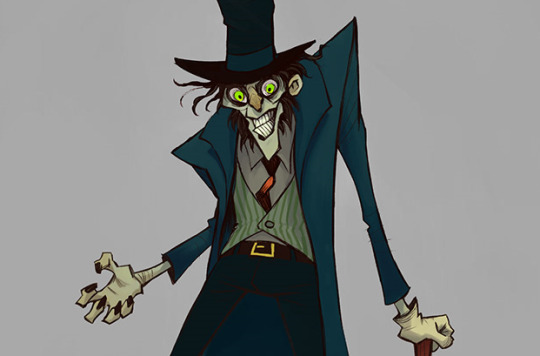
(Fan-art by guilhermefranco)
Part of what makes Mr Hyde such a powerful and lasting icon of pop culture is that the very premise of the book invites a personal reading that's gonna vary from person to person. Because everyone's familiar with the basic twist of the story, that it's a conflict of duality, of the good and evil sides, but everyone has a more personal idea of what those entail. Some people make the story more about class. A lot of readings laser-focus on sex and lust as the driving force, and there's also a lot of readings of Mr Hyde that tackle it to explore a more gendered perspective, and so forth.
I don't particularly take much notice of the Jekyll & Hyde adaptations partially because the novel's premise and themes have become baked so throughly into pop culture and explored in so many different and interesting ways, that I'm not particularly starving for good Jekyll & Hyde adaptations the way I am for Dracula and Frankenstein. The Fredric March film in particular is one that orbits my head less because of the film itself (although I do recommend it), but because of one specific scene, and that's when Jekyll first transforms into Hyde on screen.
Out of all the things they could have shown him doing right that second, they instead took the time to show him enjoying the rain.

Just Hyde taking off his hat and letting it all cascade on his face with this sheer enthusiasm like he's never been to the rain before, never enjoyed it before, and now that he's free from being Jekyll, he gets to enjoy life like he never has before. It's such an oddly humanizing moment to put amidst a horror movie, in the scene where you're ostensibly introducing the monster to the audience, and it makes such a stark contrast to the rest of the film where Hyde is completely irredeemable, but I think it's that contrast that makes the film's take on Hyde work so well even with it's diverging from the source material, even if I don't particularly like in general interpretations of Hyde that are focused on a sexual aspect.
Because one, it understands that Jekyll was fundamentally a self-serving coward and not a paragon of goodness, and two, it also understands one of the things that makes Hyde scary: He wants what all of us want, to live and be happy. He's happy when he leaves the lab and dances around in the rain like a giddy child, he's happy when he goes to places Jekyll couldn't dream of showing up, he's happy as a showgirl-abusing sexual predator. Hyde is all wants, all the time, and there's not that much difference between his wants, his domineering possessiveness, and the likes exhibited by Muriel's father and Jekyll's own within the very same film, which also works to emphasize one of the other ideas of the original story, that Edward Hyde doesn't come from nowhere. That no monster is closer to humanity than Mr Hyde, because he is us. He is the thing that Jekyll refused to take responsability for until it was too late.

(Art by LorenzoMastroianni)
While many of the ideas that defined Mr Hyde had already been explored in pop culture beforehand, Hyde popularized and redefined many of them in particular by modernizing the idea. He was the werewolf, the doppelganger, The Player On The Other Side, except he came from within. He was not transformed by circumstance, he made himself that way, and the elixir merely brought out something already inside his soul. To acknowledge that he's there is to acknowledge that he is you, and to not do that is to either lose to him, or perish. Hyde was there to address both the rot settling in Victorian society as well as grappling concerns over Darwinian heritage, of the realization that man has always had the beast inside of him (it's no accident that Hyde's main method of murder is by clubbing people to death with his cane like a caveman).
I've already argued on my post about Tarzan that the Wild Man archetype, beginning with Enkidu of The Epic of Gilgamesh, is the in-between man and beast, between superhero and monster, and that Mr Hyde is an essential component of the superhero's trajectory, as the creature split in between. That stories about dual personalities, doppelgangers, the duality of the soul, the hero with a day job and an after dark career, you can pinpoint Hyde as a turning point in how all of these solidified gradually in pop culture. And I've argued otherwise that The Punisher, for all that his image and narrative points otherwise, is ultimately just as much of a superhero as the rest of them, even if no one wants to admit it, drawing a parallel between The Punisher and Mr Hyde. And he's far from the only modern character that can invite this kind of parallel.
The idea of a regular person periodically or permanently transforming into, or revealing itself to be, something extraordinary and fantastic and scary, grappling with the divide it causes in their soul, and questions whether it's a new development or merely the truest parts of themselves coming to light at last, and the effects this transformation has for good and bad alike. The idea of a potent, dangerous, unpredictable enemy who ultimately is you, or at least a facet of you and what you can do. That these are bound to destroy each other if not reconciled with or overcome.
You know what are my thoughts on the archetype of "human periodically changing into a monster" are? Look around you and you're gonna see the myriad ways The Strange Case of Dr Jekyll and Mr Hyde's themes have manifested in the century and a half since the story's release. Why it shouldn't be any surprise whatsoever that Mr Hyde has become such an integral part of pop culture, in it's heroes and monsters alike. Why we can never escape Mr Hyde, just as Jekyll never could.
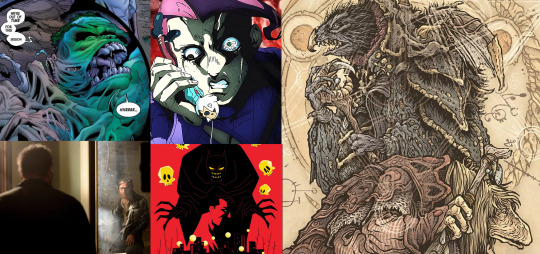
It is Nixon himself who represents that dark, venal and incurably violent side of the American character that almost every country in the world has learned to fear and despise. Our Barbie-doll president, with his Barbie-doll wife and his boxful of Barbie-doll children is also America's answer to the monstrous Mr. Hyde.
He speaks for the Werewolf in us; the bully, the predatory shyster who turns into something unspeakable, full of claws and bleeding string-warts on nights when the moon comes too close… - Hunter S. Thompson

There is a scene in the movie Pulp Fiction that explains almost every terrible thing happening in the news today. And it's not the scene where Ving Rhames shoots that guy's dick off. It's the part where the hit man played by John Travolta is talking about how somebody vandalized his car, and says this:
"Boy, I wish I could've caught him doing it. I'd have given anything to catch that asshole doing it. It'd been worth him doing it, just so I could've caught him doing it."
That last sentence is something everyone should understand about mankind. After all, the statement is completely illogical -- revenge is supposed to be about righting a wrong. But he wants to be wronged, specifically so he'll have an excuse to get revenge. We all do.
Why else would we love a good revenge movie? We sit in a theater and watch Liam Neeson's daughter get kidnapped. We're not sad about it, because we know he's a badass and he finally has permission to be awesome. Not a single person in that theater was rooting for it to all be an innocent misunderstanding. We wanted Liam to be wronged, because we wanted to see him kick ass. It's why so many people walk around with vigilante fantasies in their heads.
Long, long ago, the people in charge figured out that the easiest and most reliable way to bind a society together was by controlling and channeling our hate addiction. That's the reason why seeing hurricane wreckage on the news makes us mumble "That's sad" and maybe donate a few bucks to the Red Cross hurricane fund, while 9/11 sends us into a decade-long trillion-dollar rage that leaves the Middle East in flames.
The former was caused by wind; the latter was caused by monsters. The former makes us kind of bummed out; the latter gets us high.
It's easy to blame the news media for pumping us full of stories of mass shootings and kidnapped children, but that's stopping one step short of the answer: The media just gives us what we want. And what we want is to think we're beset on all sides by monsters.

The really popular stories will always feature monsters that are as different from us as possible. Think about Star Wars -- what real shithead has ever referred to himself as being on "the dark side"? In Harry Potter and countless fantasy universes, you have wizards working in "black magic" and the "dark arts." Can you imagine a scientist developing some technology for chemical weapons or invasive advertising openly thinking of what he does as "dark science"? Can you imagine a real world leader naming his headquarters "The Death Star" or "Mount Doom"?
Of course not. But we need to believe that evil people know they're evil, or else that would open the door to the fact that we might be evil without knowing it. I mean, sure, maybe we've bought chocolate that was made using child slaves or driven cars that poisoned the air, but we didn't do it to be evil -- we were simply doing whatever we felt like and ignoring the consequences. Not like Hitler and the bankers who ruined the economy and those people who burned the kittens -- they wake up every day intentionally dreaming up new evils to create. It's not like Hitler actually thought he was saving the world.
So no matter how many times you vote to cut food stamps and then use the money to buy a boat, you could still be way worse. You could, after all, be one of those murdering / lazy / ignorant / greedy / oppressive monsters that you know the world is full of, and that only your awesome moral code prevents you from turning into at any moment. And those monsters are out there.
They have to be. Because otherwise, we're the monsters - 5 Reasons Humanity Desperately Wants Monsters To Be Real, by Jason Pargin
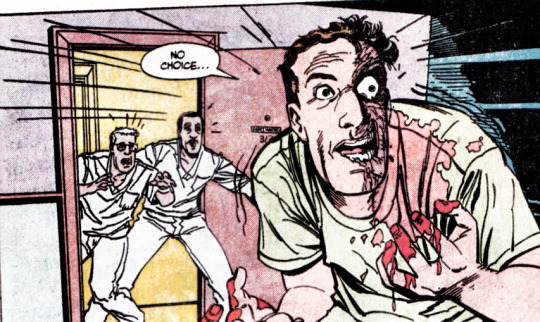
(Two-Face sequence comes from the end of Batman Annual #14: Eye of the Beholder)
For good or bad, Hyde has become omnipresent. He's a part of our superheroes, he's a part of our supervillains, he's in our monsters. He lives and prattles in our ears, sometimes we need him to survive, and sometimes we become Hyde even when we don't need to, because our survival instincts or base cruelties or desperation brings out the worst in us. Sometimes we can beat him, and sometimes he's not that bad. Sometimes we do need to appease him and listen to what he says, about us and the world around us. And sometimes we need to do so specifically to prove him wrong and beat him again.
But he never, ever goes away, as he so accurately declares in the musical
Do you really think
That I would ever let you go...
Do you think
I'd ever set you free?
If you do, I'm sad to say
It simply isn't so
You will never get away
FROM MEEEEEE
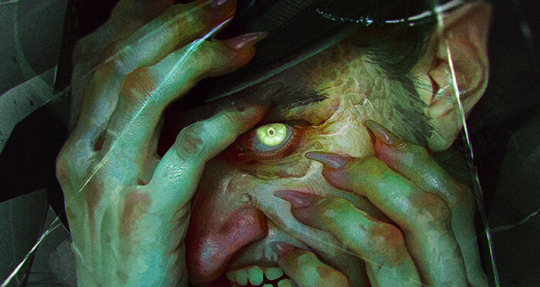
(Art by Akreon on Artstation)
#tw: injury#tw: blood#tw: disfigurement#replies tag#dr jekyll and mr hyde#the strange case of dr jekyll and mr hyde#robert louis stevenson#two-face#batman#monster tag#universal monsters#horror tag
61 notes
·
View notes